 World Ocean and the Great Barrier Reef
World Ocean and the Great Barrier Reef
Before I started to work on the “Finished Second Artwork of Malcolm X Shabazz High School Students’ Peace Comments (Poster 1 and 3)” I did some research on World Ocean and the Great Barrier Reef. I learned a lot from the information that I obtained. I decided to post the information on my Blog page incase students, teachers or anyone who wants to know more about the largest surface on earth can do so. We can learn how beautiful and fragile our oceans, marine life and coral reefs are.
Ing-On Vibulbhan-Watts, Monday, August 03, 2015
World Ocean
From Wikipedia, the free encyclopedia
https://en.wikipedia.org/wiki/World_Ocean
The World Ocean, world ocean, or global ocean, is the interconnected system of Earth‘s oceanic (or marine) waters, and comprises the bulk of the hydrosphere, covering almost 70% of Earth’s surface, with a total volume of 1.332 billion cubic kilometers.[1]
A continuous body of water encircling Earth. The unity and continuity of the World Ocean, with relatively free interchange among its parts, is of fundamental importance to oceanography.[2] It is divided into a number of principal oceanic areas that are delimited by the continents and various oceanographic features: five oceanic divisions are the Atlantic Ocean, Arctic Ocean (sometimes considered a sea of the Atlantic), Indian Ocean, Pacific Ocean, and Southern Ocean (often reckoned instead as just the southern portions of the Atlantic, Indian, and Pacific Oceans). In turn, oceanic waters are interspersed by many smaller seas, gulfs, and bays.
A global ocean has existed in one form or another on Earth for eons, and the notion dates back to classical antiquity (in the form of Oceanus). The contemporary concept of the World Ocean was coined in the early 20th century by the Russian oceanographer Yuly Shokalsky to refer to what is basically a solitary, continuous ocean that covers and encircles most of Earth.[3]
If viewed from the southern pole of Earth, the Atlantic, Indian, and Pacific Oceans can be seen as lobes extending northward from the Southern Ocean. Farther north, the Atlantic opens into the Arctic Ocean, which is connected to the Pacific by the Bering Strait, forming a continuous expanse of water.
- The Pacific Ocean, the largest of the oceans, also reaches northward from the Southern Ocean to the Arctic Ocean. It spans the gap between Australia, Asia, the Americas and Oceania. The Pacific Ocean meets the Atlantic south of South America at Cape Horn.
- The Atlantic Ocean, the second largest, extends from the Southern Ocean between South America, Africa, North America and Europe, to the Arctic Ocean. The Atlantic meets the Indian Ocean south of Africa at Cape Agulhas.
- The Indian Ocean extends northward from the Southern Ocean to India, between Africa and Australia. The Indian Ocean joins the Pacific Ocean to the east, near Australia.
- The Arctic Ocean is the smallest of the five. It joins the Atlantic near Greenland and Iceland and joins the Pacific at the Bering Strait. It overlies the North Pole, touching North America in the Western hemisphere and Scandinavia and Siberia in the Eastern hemisphere. The Arctic Ocean is partially covered in sea ice, the extent of which varies according to the season.
- The Southern Ocean is a proposed ocean surrounding Antarctica, dominated by the Antarctic Circumpolar Current, generally the ocean south of sixty degrees south latitude. The Southern Ocean is partially covered in sea ice, the extent of which varies according to the season. The Southern Ocean is the second smallest of the five named oceans.
The World Five Oceans
The Pacific Ocean is the largest of the world’s five oceans, followed by the Atlantic Ocean, Indian Ocean, Southern Ocean, and Arctic Ocean.
World Ocean Day began on 8 June 1992 at the Earth Summit in Rio de Janeiro, Brazil. However, it is not an officially recognized secular holiday by the United Nations as of yet.
Global pollution and over-consumption of fish have resulted in drastically dwindling population of the majority of species.
The ocean covers 71 percent of the Earth’s surface and contains 97 percent of the planet’s water, yet more than 95 percent of the underwater world remains unexplored. The ocean and lakes play an integral role in many of the Earth’s systems including climate and weather. The ocean supports the life of nearly 50 percent of all species on Earth and helps sustain that life providing 20 percent of the animal protein and five percent of the total protein in the human diet.
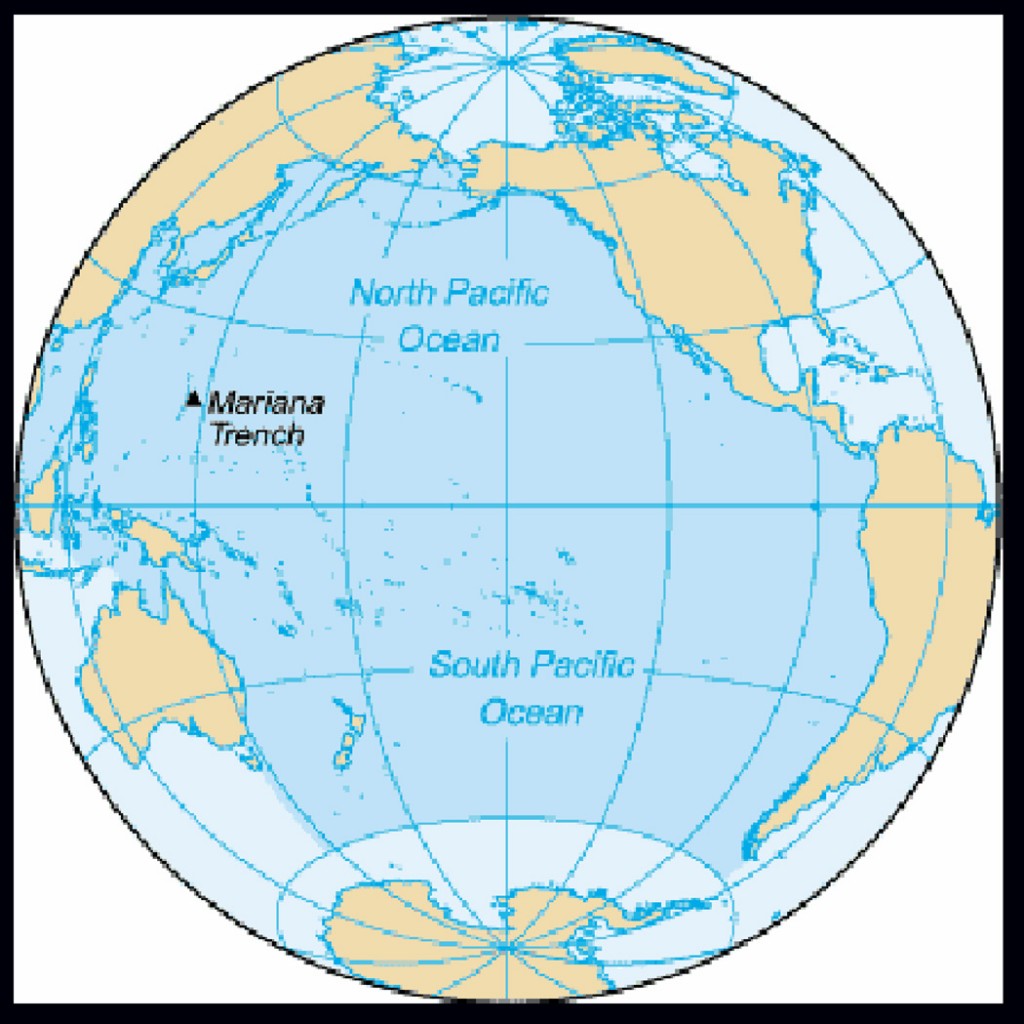 The Pacific Ocean is the largest of the world’s five oceans
The Pacific Ocean is the largest of the world’s five oceans
Area:
total: 155.557 million sq km
note: includes Bali Sea, Bering Sea, Bering Strait, Coral Sea, East China Sea, Gulf of Alaska, Gulf of Tonkin, Philippine Sea, Sea of Japan, Sea of Okhotsk, South China Sea, Tasman Sea, and other tributary water bodies
Natural resources:
The Pacific Ocean has oil and gas fields, polymetallic nodules, sand and gravel aggregates, placer deposits, fish
Ports and terminals:
Bangkok (Thailand), Hong Kong (China), Kao-hsiung (Taiwan), Los Angeles (US), Manila (Philippines), Pusan (South Korea), San Francisco (US), Seattle (US), Shanghai (China), Singapore, Sydney (Australia), Vladivostok (Russia), Wellington (NZ), Yokohama (Japan)
Environment – current issues:
Pacific Ocean endangered marine species include the dugong, sea lion, sea otter, seals, turtles, and whales; oil pollution in Philippine Sea and South China Sea
The Pacific Ocean is a major contributor to the world economy and particularly to those nations its waters directly touch. It provides low-cost sea transportation between East and West, extensive fishing grounds, offshore oil and gas fields, minerals, and sand and gravel for the construction industry. In 1996, over 60% of the world’s fish catch came from the Pacific Ocean. Exploitation of offshore oil and gas reserves is playing an ever-increasing role in the energy supplies of the US, Australia, NZ, China, and Peru. The high cost of recovering offshore oil and gas, combined with the wide swings in world prices for oil since 1985, has led to fluctuations in new drillings.
Geography – note:
The Pacific Ocean has major chokepoints are the Bering Strait, Panama Canal, Luzon Strait, and the Singapore Strait; the Equator divides the Pacific Ocean into the North Pacific Ocean and the South Pacific Ocean; dotted with low coral islands and rugged volcanic islands in the southwestern Pacific Ocean
Transportation – note:
Inside Passage offers protected waters from southeast Alaska to Puget Sound (Washington state); the International Maritime Bureau reports the territorial waters of littoral states and offshore waters in the South China Sea as high risk for piracy and armed robbery against ships; numerous commercial vessels have been attacked and hijacked both at anchor and while underway; hijacked vessels are often disguised and cargoes stolen; crew and passengers are often held for ransom, murdered, or cast adrift.
The Pacific Ocean is the largest of the world’s five oceans (followed by the Atlantic Ocean, Indian Ocean, Southern Ocean, and Arctic Ocean). Strategically important access waterways include the La Perouse, Tsugaru, Tsushima, Taiwan, Singapore, and Torres Straits. The decision by the International Hydrographic Organization in the spring of 2000 to delimit a fifth ocean, the Southern Ocean, removed the portion of the Pacific Ocean south of 60 degrees south.
Mariana Trench, depression in the floor of the Pacific Ocean, the deepest seafloor depression in the world. It is located just east of the Mariana Islands in the western part of the ocean basin. The Mariana Trench is an arc-shaped valley extending generally northeast to southwest for 2,550 km (1,580 mi); its average width is 70 km (40 mi). The Mariana is one of many deepwater ocean trenches formed by the geologic process of subduction
Natural hazards:
The Pacific Ocean is surrounded by a zone of violent volcanic and earthquake activity sometimes referred to as the “Pacific Ring of Fire”; subject to tropical cyclones (typhoons) in southeast and east Asia from May to December (most frequent from July to October); tropical cyclones (hurricanes) may form south of Mexico and strike Central America and Mexico from June to October (most common in August and September); cyclical El Nino/La Nina phenomenon occurs in the equatorial Pacific, influencing weather in the Western Hemisphere and the western Pacific; ships subject to superstructure icing in extreme north from October to May; persistent fog in the northern Pacific can be a maritime hazard from June to December
Twice the size of Texas
Ban the use of plastic before it’s too late or maybe it is already
Should plastic bags be banned?
All the Yes points
- environmental damage
- Repairing the Damage
- The Great Waste
- Non-biodegradable
- They litter our streets
- Plastic bags suffocate and kill
- Wildlife concerns
- Spread Awareness
- Environment destroyement
- Paper
- It messes up future with too much plastic bags and ends ups that we might have to leave earth.
All the No points
- No need to ban, add a tax
- Used as a marketing ploy
- Freedom of choice
- people forget their re-useable bags
- Causes expense to consumers in a time of recession
- causes loss of jobs
- People can and do recycle plastic bags
- the environmental war needs to be won elsewhere
- Loss of Technology
- so what do we carry our shopping in?
- what if u bought them and u livd far away and you frove to the shopping centre and you 4 got youor plastic bags
- other packaging
- products making
- PLASTIC BAGS DONT HARM THE ENVIRONMENT
- NO,need to ban just reduce the use of plastic
Source: debatewise.org
657 New Islands Discovered Worldwide
Japan Nuke Plant Dumps Millions of Gallons of Radioactive Water Into Pacific
https://theworldsoceans.com/atlantic.html
The Atlantic Ocean is the second-largest of the world’s oceans
Area:
total: 76.762 million sq km
note: includes Baltic Sea, Black Sea, Caribbean Sea, Davis Strait, Denmark Strait, part of the Drake Passage, Gulf of Mexico, Labrador Sea, Mediterranean Sea, North Sea, Norwegian Sea, almost all of the Scotia Sea, and other tributary water bodies
Natural resources:
oil and gas fields, fish, marine mammals (seals and whales), sand and gravel aggregates, placer deposits, polymetallic nodules, precious stones
Environment – current issues:
endangered marine species include the manatee, seals, sea lions, turtles, and whales; drift net fishing is hastening the decline of fish stocks and contributing to international disputes; municipal sludge pollution off eastern US, southern Brazil, and eastern Argentina; oil pollution in Caribbean Sea, Gulf of Mexico, Lake Maracaibo, Mediterranean Sea, and North Sea; industrial waste and municipal sewage pollution in Baltic Sea, North Sea, and Mediterranean Sea
Ports and terminals:
Alexandria (Egypt), Algiers (Algeria), Antwerp (Belgium), Barcelona (Spain), Buenos Aires (Argentina), Casablanca (Morocco), Colon (Panama), Copenhagen (Denmark), Dakar (Senegal), Gdansk (Poland), Hamburg (Germany), Helsinki (Finland), Las Palmas (Canary Islands, Spain), Le Havre (France), Lisbon (Portugal), London (UK), Marseille (France), Montevideo (Uruguay), Montreal (Canada), Naples (Italy), New Orleans (US), New York (US), Oran (Algeria), Oslo (Norway), Peiraiefs or Piraeus (Greece), Rio de Janeiro (Brazil), Rotterdam (Netherlands), Saint Petersburg (Russia), Stockholm (Sweden)
Natural hazards:
icebergs common in Davis Strait, Denmark Strait, and the northwestern Atlantic Ocean from February to August and have been spotted as far south as Bermuda and the Madeira Islands; ships subject to superstructure icing in extreme northern Atlantic from October to May; persistent fog can be a maritime hazard from May to September; hurricanes (May to December)
Geography – note:
major chokepoints include the Dardanelles, Strait of Gibraltar, access to the Panama and Suez Canals; strategic straits include the Strait of Dover, Straits of Florida, Mona Passage, The Sound (Oresund), and Windward Passage; the Equator divides the Atlantic Ocean into the North Atlantic Ocean and South Atlantic Ocean
Economy – overview:
The Atlantic Ocean provides some of the world’s most heavily trafficked sea routes, between and within the Eastern and Western Hemispheres. Other economic activity includes the exploitation of natural resources, e.g., fishing, dredging of aragonite sands (The Bahamas), and production of crude oil and natural gas (Caribbean Sea, Gulf of Mexico, and North Sea).
South Atlantic Flash
The Vela Incident (sometimes referred to as the South Atlantic Flash) was an unidentified “double flash” of light that was detected by an American Vela Hotel satellite on September 22, 1979.
Some specialists who examined the data speculated that the double flash, characteristic of a nuclear explosion, may have been the result of a nuclear weapons test: “The conclusions of the Presidential panel (the Ad Hoc Panel) were reassuring, as they suggested that the most likely explanation of the Vela detection was a meteoroid hitting the satellite — in part because of the discrepancy in bhangmeter readings. Others who examined the data, including Defense Intelligence Agency (DIA), the national laboratories, and defense contractors reached a very different conclusion — that the data supported the conclusion that on 22 September 1979, Vela 6911 had detected a nuclear detonation.
Source: Wikipedia
The Atlantic Ocean is the second largest of the world’s five oceans (after the Pacific Ocean, but larger than the Indian Ocean, Southern Ocean, and Arctic Ocean). The Kiel Canal (Germany), Oresund (Denmark-Sweden), Bosporus (Turkey), Strait of Gibraltar (Morocco-Spain), and the Saint Lawrence Seaway (Canada-US) are important strategic access waterways. The decision by the International Hydrographic Organization in the spring of 2000 to delimit a fifth world ocean, the Southern Ocean, removed the portion of the Atlantic Ocean south of 60 degrees south latitude.
Tropical cyclones (hurricanes) develop off the coast of Africa near Cape Verde and move westward into the Caribbean Sea; hurricanes can occur from May to December but are most frequent from August to November
The surface usually covered with sea ice in Labrador Sea, Denmark Strait, and coastal portions of the Baltic Sea from October to June; clockwise warm-water gyre (broad, circular system of currents) in the northern Atlantic, counterclockwise warm-water gyre in the southern Atlantic; the ocean floor is dominated by the Mid-Atlantic Ridge, a rugged north-south centerline for the entire Atlantic basin
The lowest point: Milwaukee Deep in the Puerto Rico Trench -8,605 m
Transportation – note:
Kiel Canal and Saint Lawrence Seaway are two important waterways; significant domestic commercial and recreational use of Intracoastal Waterway on central and south Atlantic seaboard and Gulf of Mexico coast of US; the International Maritime Bureau reports the territorial waters of littoral states and offshore Atlantic waters as high risk for piracy and armed robbery against ships, particularly in the Gulf of Guinea off West Africa, the east coast of Brazil, and the Caribbean Sea; numerous commercial vessels have been attacked and hijacked both at anchor and while underway; hijacked vessels are often disguised and cargoes stolen; crews have been robbed and stores or cargoes stolen
https://theworldsoceans.com/indian.html
The Indian Ocean is the third largest of the world’s five oceans
Area:
total: 68.556 million sq km
note: includes Andaman Sea, Arabian Sea, Bay of Bengal, Flores Sea, Great Australian Bight, Gulf of Aden, Gulf of Oman, Java Sea, Mozambique Channel, Persian Gulf, Red Sea, Savu Sea, Strait of Malacca, Timor Sea, and other tributary water bodies
Environment – current issues:
The Indian Ocean endangered marine species include the dugong, seals, sea turtles, and whales; oil pollution in the Arabian Sea, Persian Gulf, and Red Sea
Natural resources:
The Indian Ocean oil and gas fields, fish, shrimp, sand and gravel aggregates, placer deposits, polymetallic nodules
Ports and terminals:
Chennai(Madras, India), Colombo(Sri Lanka), Durban (South Africa) Jakarta (Indonesia), Kolkata (Calcutta India) Melbourne (Australia), Mumbai (Bombay, India), Richards Bay (South Africa)
Natural hazards:
The Indian Ocean occasional icebergs pose navigational hazard in southern reaches
Geography – note:
major chokepoints in Indian Ocean include Bab el Mandeb, Strait of Hormuz, Strait of Malacca, southern access to the Suez Canal, and the Lombok Strait
Economy – overview:
The Indian Ocean provides major sea routes connecting the Middle East, Africa, and East Asia with Europe and the Americas. It carries a particularly heavy traffic of petroleum and petroleum products from the oilfields of the Persian Gulf and Indonesia. Its fish are of great and growing importance to the bordering countries for domestic consumption and export. Fishing fleets from Russia, Japan, South Korea, and Taiwan also exploit the Indian Ocean, mainly for shrimp and tuna. Large reserves of hydrocarbons are being tapped in the offshore areas of Saudi Arabia, Iran, India, and western Australia. An estimated 40% of the world’s offshore oil production comes from the Indian Ocean. Beach sands rich in heavy minerals and offshore placer deposits are actively exploited by bordering countries, particularly India, South Africa, Indonesia, Sri Lanka, and Thailand
The Indian Ocean northeast monsoon (December to April), southwest monsoon (June to October); tropical cyclones occur during May/June and October/November in the northern Indian Ocean and January/February in the southern Indian Ocean
The Indian Ocean surface dominated by counterclockwise gyre (broad, circular system of currents) in the southern Indian Ocean; unique reversal of surface currents in the northern Indian Ocean; low atmospheric pressure over southwest Asia from hot, rising, summer air results in the southwest monsoon and southwest-to-northeast winds and currents, while high pressure over
northern Asia from cold, falling, winter air results in the northeast monsoon and northeast-to-southwest winds and currents; ocean floor is dominated by the Mid-Indian Ocean Ridge and subdivided by the Southeast Indian Ocean Ridge, Southwest Indian Ocean Ridge, and Ninetyeast Ridge
The Indian Ocean lowest point: Java Trench -7,258 m
Transportation – note:
The International Maritime Bureau reports the territorial waters of littoral states and offshore waters as high risk for piracy and armed robbery against ships, particularly in the Gulf of Aden, along the east coast of Africa, the Bay of Bengal, and the Strait of Malacca; numerous vessels, including commercial shipping and pleasure craft, have been attacked and hijacked both at anchor and while underway; hijacked vessels are often disguised and cargoes stolen; crew and passengers are often held for ransom, murdered, or cast adrift.
https://theworldsoceans.com/southern.html
Southern Ocean
The Southern Ocean as the fourth-largest of the five oceans
The Southern Ocean, also known as the Great Southern Ocean, the Antarctic Ocean and the South Polar Ocean
Area:
total: 20.327 million sq km
note: includes Amundsen Sea, Bellingshausen Sea, part of the Drake Passage, Ross Sea, a small part of the Scotia Sea, Weddell Sea, and other tributary water bodies
Natural resources:
Probable large and possible giant oil and gas fields on the continental margin; manganese nodules, possible placer deposits, sand and gravel, fresh water as icebergs; squid, whales, and seals – none exploited; krill, fish
Environment – current issues:
increased solar ultraviolet radiation resulting from the Antarctic ozone hole in recent years, reducing marine primary productivity (phytoplankton) by as much as 15% and damaging the DNA of some fish; illegal, unreported, and unregulated fishing in recent years, especially the landing of an estimated five to six times more Patagonian toothfish than the regulated fishery, which is likely to affect the sustainability of the stock; large amount of incidental mortality of seabirds resulting from long-line fishing for toothfish
note: the now-protected fur seal population is making a strong comeback after severe overexploitation in the 18th and 19th centuries
Ports and terminals:
McMurdo, Palmer, and offshore anchorages in Antarctica
Note: few ports or harbors exist on southern side of Southern Ocean; ice conditions limit use of most to short periods in midsummer; even then some cannot be entered without icebreaker escort; most Antarctic ports are operated by government research stations and, except in an emergency, are not open to commercial or private vessels; vessels in any port south of 60 degrees south are subject to inspection by observers under Article 7 of the Antarctic Treaty; The Hydrographic Committee on Antarctica (HCA), a special hydrographic commission of International Hydrographic Organization (IHO), is responsible for hydrographic surveying and nautical charting matters in Antarctic
Treaty area; it coordinates and facilitates provision of accurate and appropriate charts and other aids to navigation in support of safety of navigation in region; membership of HCA is open to any IHO Member State whose government has acceded to the Antarctic Treaty and which contributes resources and/or data to IHO Chart coverage of the area; members of HCA are Argentina, Australia, Brazil, Chile, China, Ecuador, France, Germany, Greece, India, Italy, NZ, Norway, Russia, South Africa, Spain, UK, and US (2007)
Terrain:
the Southern Ocean is deep, 4,000 to 5,000 m over most of its extent with only limited areas of shallow water; the Antarctic continental shelf is generally narrow and unusually deep, its edge lying at depths of 400 to 800 m (the global mean is 133 m); the Antarctic
icepack grows from an average minimum of 2.6 million sq km in March to about 18.8 million sq km in September, better than a sixfold increase in area; the Antarctic Circumpolar Current (21,000 km in length) moves perpetually eastward; it is the world’s largest ocean current, transporting 130 million cubic meters of water per second – 100 times the flow of all the world’s rivers
lowest point: -7,235 m at the southern end of the South Sandwich Trench
Natural hazards:
huge icebergs with drafts up to several hundred meters; smaller bergs and iceberg fragments; sea ice (generally 0.5 to 1 m thick) with sometimes dynamic short-term variations and with large annual and interannual variations; deep continental shelf floored by glacial deposits varying widely over short distances; high winds and large waves much of the year; ship icing, especially May-October; most of region is remote from sources of search and rescue
Geography – note:
the major chokepoint is the Drake Passage between South America and Antarctica; the Polar Front (Antarctic Convergence) is the best natural definition of the northern extent of the Southern Ocean; it is a distinct region at the middle of the Antarctic Circumpolar Current that separates the cold polar surface waters to the south from the warmer waters to the north; the Front and the Current extend entirely around Antarctica, reaching south of 60 degrees south near New Zealand and near 48 degrees south in the far South Atlantic coinciding with the path of the maximum westerly winds
Disputes – international:
Antarctic Treaty defers claims, but Argentina, Australia, Chile, France, NZ, Norway, and UK assert claims (some overlapping), including the continental shelf in the Southern Ocean; several states have expressed an interest in extending those continental shelf claims under the United Nations Convention on the Law of the Sea (UNCLOS) to include undersea ridges; the US and most other states do not recognize the land or maritime claims of other states and have made no claims themselves (the US and Russia have reserved the right to do so); no formal claims exist in the waters in the sector between 90 degrees west and 150 degrees west
Environment – current issues:
increased solar ultraviolet radiation resulting from the Antarctic ozone hole in recent years, reducing marine primary productivity (phytoplankton) by as much as 15% and damaging the DNA of some fish; illegal, unreported, and unregulated fishing in recent years, especially the landing of an estimated five to six times more Patagonian toothfish than the regulated fishery, which is likely to affect the sustainability of the stock; large amount of incidental mortality of seabirds resulting from long-line fishing for toothfish
note: the now-protected fur seal population is making a strong comeback after severe overexploitation in the 18th and 19th centuries
Environment – international agreements:
the Southern Ocean is subject to all international agreements regarding the world’s oceans; in addition, it is subject to these agreements specific to the Antarctic region: International Whaling Commission (prohibits commercial whaling south of 40 degrees south [south of 60 degrees south between 50 degrees and 130 degrees west]); Convention on the Conservation of Antarctic Seals (limits sealing); Convention on the Conservation of Antarctic Marine Living Resources (regulates fishing)
note: many nations (including the US) prohibit mineral resource exploration and exploitation south of the fluctuating Polar Front (Antarctic Convergence), which is in the middle of the Antarctic Circumpolar Current and serves as the dividing line between the cold polar surface waters to the south and the warmer waters to the north.
Economy – overview:
Fisheries in 2006-07 landed 126,976 metric tons, of which 82% (104,586 tons) was krill (Euphausia superba) and 9.5% (12,027 tons) Patagonian toothfish (Dissostichus eleginoides – also known as Chilean sea bass), compared to 127,910 tons in 2005-06 of which 83% (106,591 tons) was krill and 9.7% (12,396 tons) Patagonian toothfish (estimated fishing from the area covered by the Convention of the Conservation of Antarctic Marine Living Resources (CCAMLR), which extends slightly beyond the Southern Ocean area). International agreements were adopted in late 1999 to reduce illegal, unreported, and unregulated fishing, which in the 2000-01 season landed, by one estimate, 8,376 metric tons of Patagonian and Antarctic toothfish. In the 2007-08 Antarctic summer, 45,213 tourists visited the Southern Ocean, compared to 35,552 in 2006-2007, and 29,799 in 2005-2006 (estimates provided to the Antarctic Treaty by the International Association of Antarctica Tour Operators (IAATO), and does not include passengers on overflights and those flying directly in and out of Antarctica).
Transportation – note:
Drake Passage offers alternative to transit through the Panama Canal
https://theworldsoceans.com/Arctic.html
The Arctic Ocean is the smallest of the world’s five oceans (after the Pacific Ocean, Atlantic Ocean, Indian Ocean, and the recently delimited Southern Ocean). The Northwest Passage (US and Canada) and Northern Sea Route (Norway and Russia) are two important seasonal waterways. A sparse network of air, ocean, river, and land routes circumscribes the Arctic Ocean.
Area:
total: 14.056 million sq km
note: includes Baffin Bay, Barents Sea, Beaufort Sea, Chukchi Sea, East Siberian Sea, Greenland Sea, Hudson Bay, Hudson Strait, Kara Sea, Laptev Sea, Northwest Passage, and other tributary water bodies
Natural resources:
sand and gravel aggregates, placer deposits, polymetallic nodules, oil and gas fields, fish, marine mammals (seals and whales)
Environment – current issues:
endangered marine species include walruses and whales; fragile ecosystem slow to change and slow to recover from disruptions or damage; thinning polar icepack
Ports and terminals:
Churchill (Canada), Murmansk (Russia), Prudhoe Bay (US)
Climate:
polar climate characterized by persistent cold
and relatively narrow annual temperature ranges; winters characterized by continuous darkness, cold and stable weather conditions, and clear skies; summers characterized by continuous daylight, damp and foggy weather, and weak cyclones with rain or snow
Terrain:
central surface covered by a perennial drifting polar icepack that, on average, is about 3 meters thick, although pressure ridges may be three times that thickness; clockwise drift pattern in the Beaufort Gyral Stream, but nearly straight-line movement from the New Siberian Islands (Russia) to Denmark Strait and whales; fragile ecosystem slow to change and slow to recover from disruptions or damage; thinning polar icepack
Geography – note:
major chokepoint is the southern Chukchi Sea (northern access to the Pacific Ocean via the Bering Strait); strategic location between North America and Russia; shortest marine link between the extremes of eastern and western Russia; floating research stations operated by the US and Russia; maximum snow cover in March or April about 20 to 50 centimeters over the frozen ocean; snow cover lasts about 10 months
Natural hazards:
ice islands occasionally break away from northern Ellesmere Island; icebergs calved from glaciers in western Greenland and extreme northeastern Canada; permafrost in islands; virtually ice locked from October to June; ships subject to superstructure icing from October to May
Disputes – international:
the littoral states are engaged in various stages of demonstrating the limits of their continental shelves beyond 200 nautical miles from their declared baselines in accordance with Article 76, paragraph 8, of the United Nations Convention on the Law of the Sea; record summer melting of sea ice in the Arctic has restimulated interest in maritime shipping lanes and sea floor exploration
Economy – overview:
Economic activity is limited to the exploitation of natural resources, including petroleum, natural gas, fish, and seals.
Transportation – note:
sparse network of air, ocean, river, and land routes; the Northwest Passage (North America) and Northern Sea Route (Eurasia) are important seasonal waterways
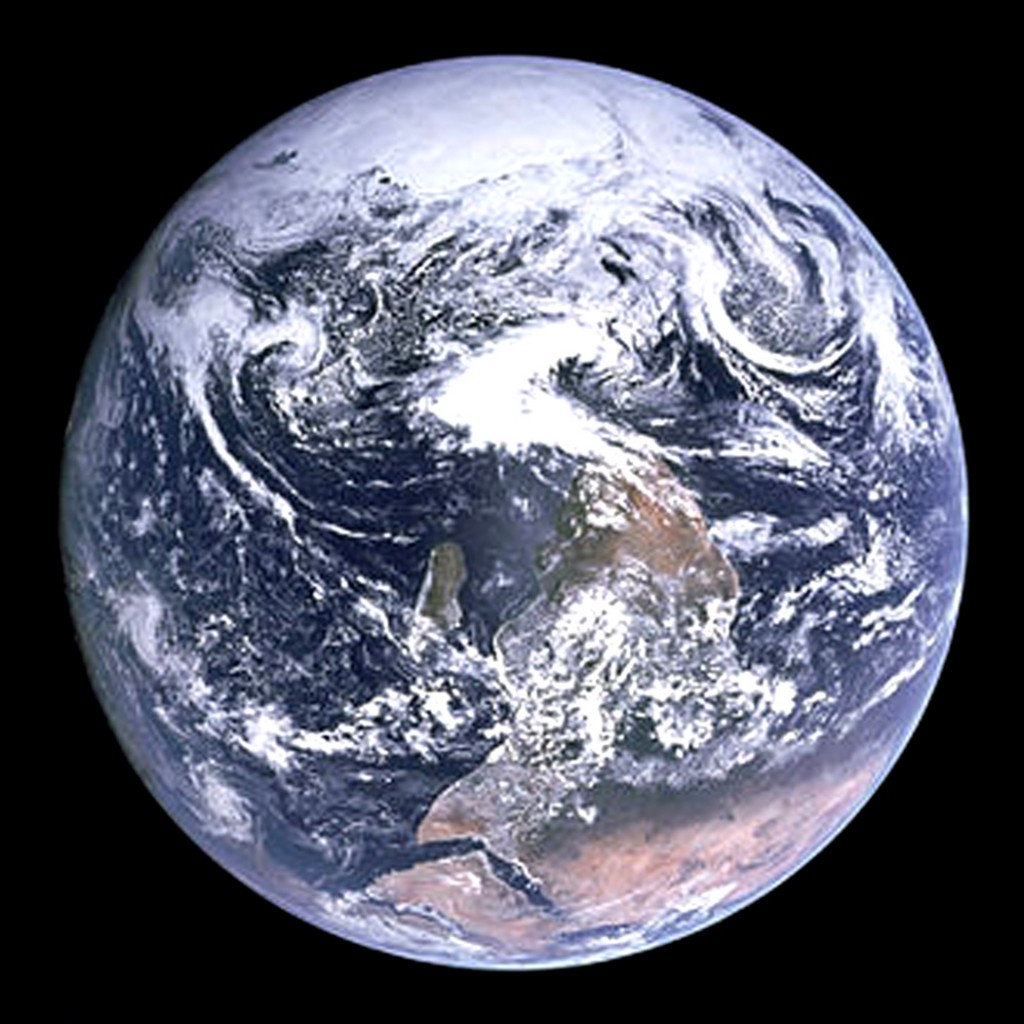 The “Blue Marble” in its original orientation, showing the junction of the Indian and Atlantic at the Cape of Good Hope.
The “Blue Marble” in its original orientation, showing the junction of the Indian and Atlantic at the Cape of Good Hope.
Earth is the only known planet with seas of liquid water on its surface,[6](p22) although Mars possesses ice caps and similar planets in other solar systems may have oceans.[14] It is still unclear where Earth’s water came from, but, seen from space, our planet appears as a “blue marble” of its various forms: oceans, ice caps, clouds.[15] Earth’s 1,335,000,000 cubic kilometers (320,000,000 cu mi)[16] of sea contain about 97.2 percent of its known water[17][c] and cover more than 70 percent of its surface.[6](p7) Another 2.15% of Earth’s water is frozen, found in the sea ice covering the Arctic Ocean, the ice cap covering Antarctica and its adjacent seas, and various glaciers and surface deposits around the world. The remainder (about 0.65% of the whole) form underground reservoirs or various stages of the water cycle, containing the freshwater encountered and used by most terrestrial life: vapor in the air, the clouds it slowly forms, the rain falling from them, and the lakes and rivers spontaneously formed as its waters flow again and again to the sea.[17] The sea’s dominance of the planet is such that the British author Arthur C. Clarke once noted that “Earth” would have been better named “Ocean”.[6](p7)
Seawater
High tides (blue) at the nearest and furthest points of the Earth from the Moon
Tides are the regular rise and fall in water level experienced by seas and oceans in response to the gravitational influences of the Moon and the Sun, and the effects of the Earth’s rotation. At any given place, the water rises over the course of the tidal cycle to a maximum height known as “high tide” before ebbing away again to a minimum “low tide” level. As the water recedes, it uncovers more and more of the foreshore or intertidal zone. The difference in height between the high tide and low tide is known as the tidal range or tidal amplitude.[56][57] Tidal bores can occur at the mouths of rivers, where the force of the incoming tide pushes waves of seawater upstream against the current. At Hangzhou in China, the bore can reach 9 meters (30 ft) high and travel up to 40 km (25 mi) per hour.
The carbon cycle
Main article: Oceanic carbon cycle
Oceans contain the greatest quantity of actively-cycled carbon in the world and are second only to the lithosphere in the amount of carbon they store.[87] The oceans’ surface layer holds large amounts of dissolved organic carbon that is exchanged rapidly with the atmosphere. The deep layer’s concentration of dissolved inorganic carbon is about 15 percent higher than that of the surface layer[88] and it remains there for much longer periods of time.[89] Thermohaline circulation exchanges carbon between these two layers.[87]
Carbon enters the ocean as atmospheric carbon dioxide dissolves into the surface layers and is converted into carbonic acid, carbonate, and bicarbonate: CO2 (aq) + H2O H2CO3 HCO3? + H+ CO32? + 2 H+. The process liberates hydrogen ions (H+
), decreasing ocean pH and increasing its acidity.
It can also enter as dissolved organic carbon through rivers and is converted by photosynthetic organisms into organic carbon. This can either be exchanged throughout the food chain or precipitated into the deeper, more carbon-rich layers as dead soft tissue or in shells and bones as calcium carbonate. It circulates in this layer for long periods of time before either being deposited as sediment or being returned to surface waters through thermohaline circulation.[89]
Acidification
Main article: Ocean acidification
Seawater is slightly alkaline and had a preindustrial pH of about 8.2. More recently, anthropogenic activities have steadily increased the carbon dioxide content of the atmosphere; about 30–40% of the added CO2 is absorbed by the oceans, forming carbonic acid and lowering the pH (now below 8.1[90]) through a process called ocean acidification.[91][92][93] The pH is expected to reach 7.7 (representing a 3-fold increase in hydrogen ion concentration) by the year 2100, which is a significant change in a century.[94][f]
One important element for the formation of skeletal material in marine animals is calcium, but calcium carbonate becomes more soluble with pressure, so carbonate shells and skeletons dissolve below its compensation depth.[96] Calcium carbonate also becomes more soluble at lower pH, so ocean acidification is likely to have profound effects on marine organisms with calcareous shells, such as oysters, clams, sea urchins, and corals,[97] because their ability to form shells will be reduced,[98] and the carbonate compensation depth will rise closer to the sea surface. Affected planktonic organisms will include the snail-like molluscs known as pteropods, and single-celled algae called coccolithophorids and foraminifera. All of these are important parts of the food chain and a diminution in their numbers will have significant consequences. In tropical regions, corals are likely to be severely affected as it becomes more difficult to build their calcium carbonate skeletons,[99] in turn adversely impacting other reef dwellers.[94]
The current rate of ocean chemistry change appears to be without precedent in Earth’s geological history, making it unclear how well marine ecosystems will be able to adapt to the shifting conditions of the near future.[100] Of particular concern is the manner in which the combination of acidification with the expected additional stressors of higher temperatures and lower oxygen levels will impact the seas.[101]
A map of mean surface chlorophyll a (1998–2006), from 0.03 (light violet) to 30 mg chl per m³ (dark red) on a logarithmic scale.
Main article: Marine biology
The oceans are home to a diverse collection of life forms that use it as a habitat. Since sunlight illuminates only the upper layers, the major part of the ocean exists in permanent darkness. As the different depth and temperature zones each provide habitat for a unique set of species, the marine environment as a whole encompasses an immense diversity of life.[102] Marine habitats range from surface water to the deepest oceanic trenches, including coral reefs, kelp forests, seagrass meadows, tidepools, muddy, sandy and rocky seabeds, and the open pelagic zone. The organisms living in the sea range from whales 30 meters (100 ft) long to microscopic phytoplankton and zooplankton, fungi, bacteria and viruses, including recently discovered marine bacteriophages which live parasitically inside bacteria.[103] Marine life plays an important part in the carbon cycle as photosynthetic organisms convert dissolved carbon dioxide into organic carbon and it is economically important to humans for providing fish for use as food.[104][105](pp204–229)
Life may have originated in the sea and all the major groups of animals are represented there. Scientists differ as to precisely where in the sea life arose: the Miller-Urey experiments suggested a dilute chemical “soup” in open water, but more recent suggestions include volcanic hot springs, fine-grained clay sediments, or deep-sea “black smoker” vents, all of which would have provided protection from damaging ultraviolet radiation which was not blocked by the early earth’s atmosphere.[6](pp138–140)
Habitats
Main article: Marine habitats
Marine habitats can be divided horizontally into coastal and open ocean habitats. Coastal habitats extend from the shoreline to the edge of the continental shelf. Most marine life is found in coastal habitats, even though the shelf area occupies only 7 percent of the total ocean area. Open ocean habitats are found in the deep ocean beyond the edge of the continental shelf. Alternatively, marine habitats can be divided vertically into pelagic (open water), demersal (just above the seabed), and benthic (sea bottom) habitats. A third division is by latitude: from tropical to temperate to polar waters.[6](pp150–151)
Coral reefs, the so-called “rainforests of the sea”, occupy less than 0.1 percent of the world’s ocean surface, yet their ecosystems include 25 percent of all marine species.[106] The best-known are tropical coral reefs such as Australia’s Great Barrier Reef, but cold water reefs harbor a wide array of species including corals (only six of which contribute to reef formation).[6](pp204–207)[107]
Algae and plants
Main article: Algae
Marine primary producers—plants and microscopic organisms in the plankton—are widespread and very diverse. Microscopic photosynthetic algae, phytoplankton, contribute a larger proportion of the world’s photosynthetic output than all the terrestrial forests combined. About 45 percent of the sea’s primary production of living material is contributed by diatoms.[108] Much larger algae, commonly known as seaweeds, are important locally; Sargassum forms floating drifts, while kelp form seabed forests.[105](pp246–255) Flowering plants in the form of seagrasses grow in “meadows” in sandy shallows,[109] mangroves line the coast in tropical and subtropical regions,[110] and salt-tolerant plants thrive in regularly inundated salt marshes.[111] All of these habitats are able to sequester large quantities of carbon and support a biodiverse range of larger and smaller animal life.[112]
Light is only able to penetrate the top 200 m (660 ft) so this is the only part of the sea where plants can grow.[36] The surface layers are often deficient in biologically-active nitrogen compounds. The marine nitrogen cycle consists of complex microbial transformations which include the fixation of nitrogen, its assimilation, nitrification, anammox, and denitrification.[113] Some of these processes take place in deep water so that where there is an upwelling of cold waters or near estuaries where land-sourced nutrients are present, plant growth is higher. This means that the most productive areas, rich in plankton and therefore also in fish, are mainly coastal.[6](pp160–163)
Animals and other life
Further information: Marine zoology
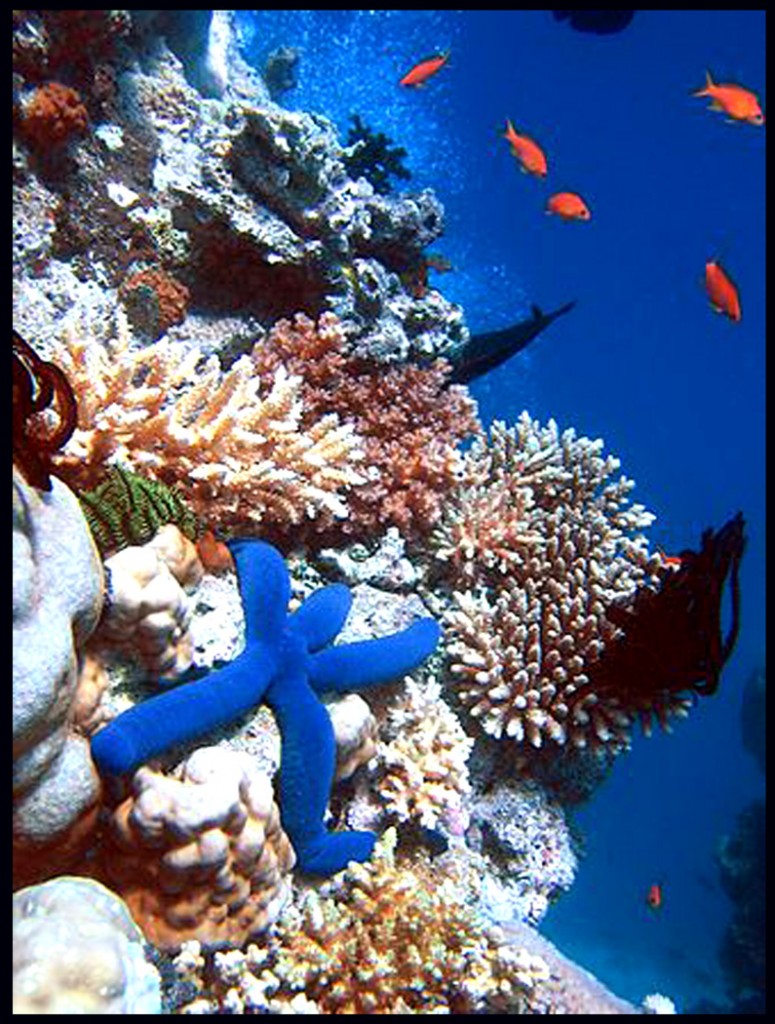 Marine habitats such as coral reefs hold a diversity of species including starfish, corals and fish.
Marine habitats such as coral reefs hold a diversity of species including starfish, corals and fish.
There is a broader spectrum of higher animal taxa in the sea than on land, many marine species have yet to be discovered, and the number known to science is expanding annually.[114] Some vertebrates such as seabirds, seals, and sea turtles return to the land to breed but fish, cetaceans, and sea snakes have a completely aquatic lifestyle and many invertebrate phyla are entirely marine. In fact, the oceans teem with life and provide many varying microhabitats.[114] One of these is the surface film which—despite being tossed about by the movement of waves—provides a rich environment and is home to bacteria, fungi, microalgae, protozoa, fish eggs, and various larvae.[115]
The pelagic zone contains macro– and microfauna and myriad zooplankton which drift with the currents. Most of the smallest organisms are the larvae of fish and marine invertebrates which liberate eggs in vast numbers because the chance of any one embryo surviving to maturity is so minute.[116] The zooplankton feed on phytoplankton and on each other and form a basic part of the complex food chain that extends through variously-sized fish and other nektonic organisms, which are in turn eaten by larger squids, sharks, porpoises, dolphins, and whales.[117] Some marine creatures make large migrations, either to other regions of the ocean on a seasonal basis or up and down its vertical layers, often ascending to feed at night before descending to safety by day.[118] Ships can introduce or spread invasive species through the discharge of ballast water or through the transport of organisms that have accumulated as part of the fouling community on the hulls of vessels.[119]
The demersal zone supports many animals that feed on benthic organisms or seek protection from predators. The seabed provides a range of habitats on or under the surface of the substrate which are used by creatures adapted to these conditions. The tidal zone with its periodic exposure to dehydrating air is home to barnacles, molluscs, and crustaceans. The neritic zone has many organisms that need light to flourish. Here, sponges, echinoderms, polychaete worms, sea anemones, and other invertebrates live among algal-encrusted rocks. Corals often contain photosynthetic symbionts and live in shallow waters where light penetrates. The extensive calcareous skeletons they extrude build up into coral reefs which are an important feature of the seabed. These provide a diverse habitat for reef dwelling organisms. There is less sea life on the floor of deeper seas but marine life also flourishes around seamounts that rise from the depths, where fish and other animals congregate to spawn and feed. Close to the seabed live demersal fish that largely feed on pelagic organisms or benthic invertebrates.[120] Exploration of the deep sea by submersibles revealed a new world of creatures living on the seabed that scientists had not previously expected. Some like the detritivores rely on organic material falling to the ocean floor. Others cluster round deep-sea hydrothermal vents where mineral-rich flows of water emerge, supporting communities whose primary producers are sulphide-oxidizing chemoautotrophic bacteria and whose consumers include specialized bivalves, sea anemones, barnacles, crabs, worms, and fish.[6](p212) A dead whale sinking to the bottom of the ocean provides food for an assembly of organisms which similarly rely largely on the actions of sulphur-reducing bacteria. Such places support unique biomes where many new microbes and other lifeforms have been discovered.[121]
Fishing
Main articles: Seafood, Fishing, Aquaculture and Whaling
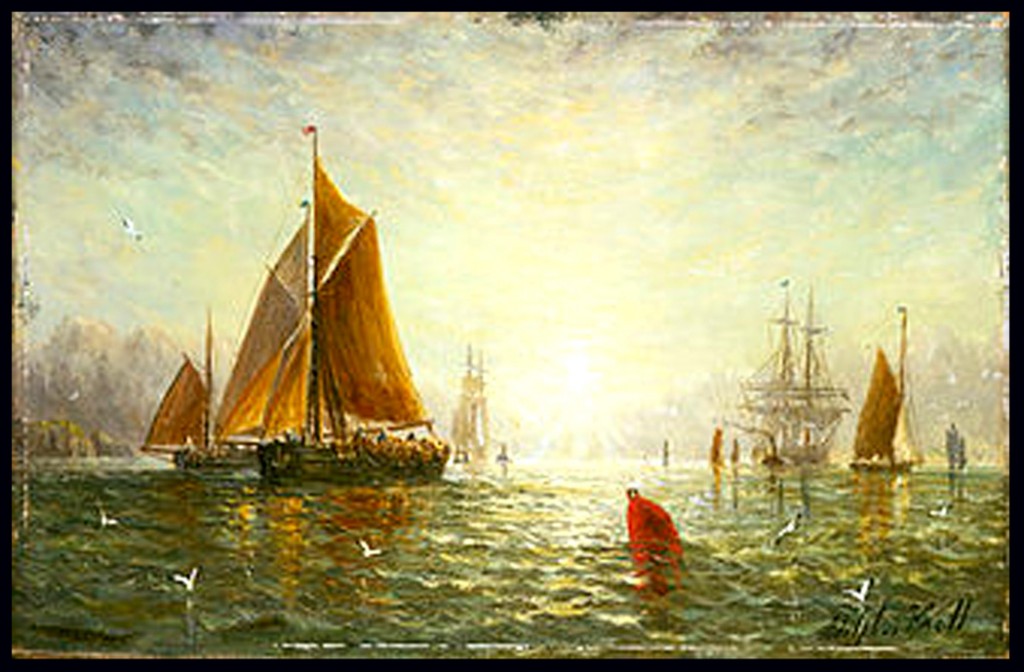 19th-century Brixham trawlers at work.
19th-century Brixham trawlers at work.
Humans in East Asia were consuming large amounts of freshwater fish around 40?000 years ago.[174] Spearfishing with barbed harpoons along the coast was widespread by the Palaeolithic.[175] Fish ponds surrounded Sumerian temples by 2?500 BC and a Chinese classical text credited to the 5th-century BC businessman Fan Li[176] is the earliest known work on fish farming.[177] A surviving fragment of Isidore of Charax‘s 1st-century Parthian itinerary describes locals freediving for pearls in the Persian Gulf,[178] and Oppian‘s 2nd-century Halieutics relates the four main Greek and Roman fishing methods as hook-and-line, netting, passive traps, and trident.[179] Traditional fishing boats operate in near-shore waters but, during the late Middle Ages and early Modern period, fishing on the open sea—particularly cod—became important to the economic and naval development of Northern Europe, New England, and Canada.[180] Overfishing along the coasts of the North Sea spurred the development of deep-sea fishers such as the Brixham[181] and otter trawlers, which might serve as motherships for longlining dories;[182] in the 19th century, advances such as rail transport, canning, and refrigeration allowed fishing to become a full-fledged industry. Improvements in sonar during the world wars were adapted as fishfinders and, during the 1950s, great factory ships caught and processed as many fish in an hour as earlier trawlers had in a season.[182] By the 1960s, the North Atlantic and North Pacific fisheries were close to maximal exploitation. After the catch from wild marine fisheries grew from 18 million metric tons (20 million tons) in 1950 to around 85 million metric tons (93 1?2 million tons) by the late 1980s, it has remained essentially constant since.[183][i] Chinese economic reform led to massive growth of its fishing production, from 7% of the world total in 1961 to 35% by 2010.[183] Scientific studies of population dynamics and nationalization of formerly shared waters are both helping to cope with overexploitation but the success of modern commercial fishing has required major corrective actions: the collapse of the Grand Banks cod fishery to less than 1% of its historic levels required a complete moratorium by Canada in 1992[184] and China has enforced a zero-growth policy in its wild catch since 2000, redirecting its industry towards aquaculture;[185] its annual months-long bans on fishing in disputed areas of the South China Sea is enforced over the protest of neighboring states.[186]
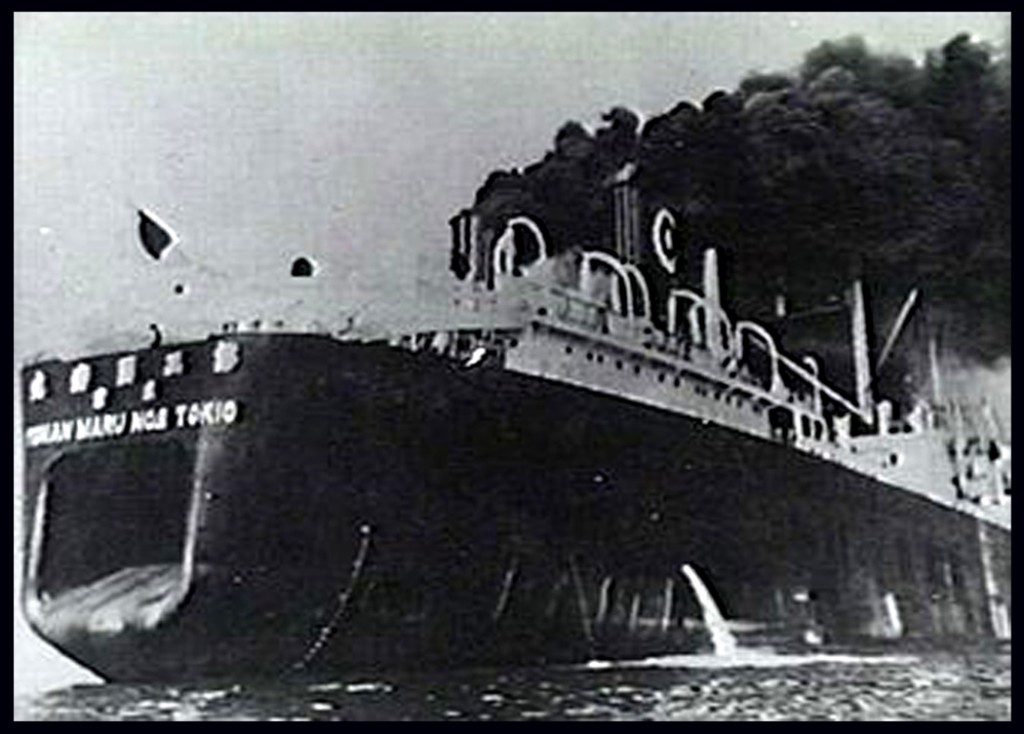 The whale factory vessel Tonan Maru ?2 was torpedoed four times but repaired or raised each time.[187] Built to Norwegian design, the Japanese whaling fleet provided half of the country’s meat supply during its American occupation and remains the world’s most active. Similar whalers in Europe inspired present-day fish processing ships.[182]
The whale factory vessel Tonan Maru ?2 was torpedoed four times but repaired or raised each time.[187] Built to Norwegian design, the Japanese whaling fleet provided half of the country’s meat supply during its American occupation and remains the world’s most active. Similar whalers in Europe inspired present-day fish processing ships.[182]
As of 2006, there were an estimated 43.5 million people involved in capturing or raising seafood, 85.5% of whom lived in Asia. About 3?4 were fishers and the remainder fish farmers.[188] In 2012, total global production of fish, crustaceans, molluscs, and other aquatic animals was a record 158 million metric tons (174 million tons), of which 91.3 million metric tons (100 million tons) were caught in the wild.[189] This is also a record if ignoring the Peruvian anchovy,[189] whose population can vary dramatically with the El Niño cycle.[190][191] The overall trend remains increasing, but due to expanding aquaculture in inland waters and mariculture in the sea rather than higher catches in the wild. The exclusive economic zones around coastal countries under the UNCLOS regime have permitted states to institute quota and other management systems[192] over the most productive regions of the sea, accounting for around 87% of the annual harvest.[193] The results are sometimes dramatic—the lull in fishing over the course of the First World War saw the North Sea‘s 1919 catch double 1913’s[182]—and sometimes much less so: two decades on, the levels of cod in the Grand Banks remain only 10% of their peak. At present, the species most frequently landed are herring, cod, anchovy, tuna, flounder, mullet, squid, and salmon. A number of these, as well as large predatory fish,[194] remain well below historical levels.[195]
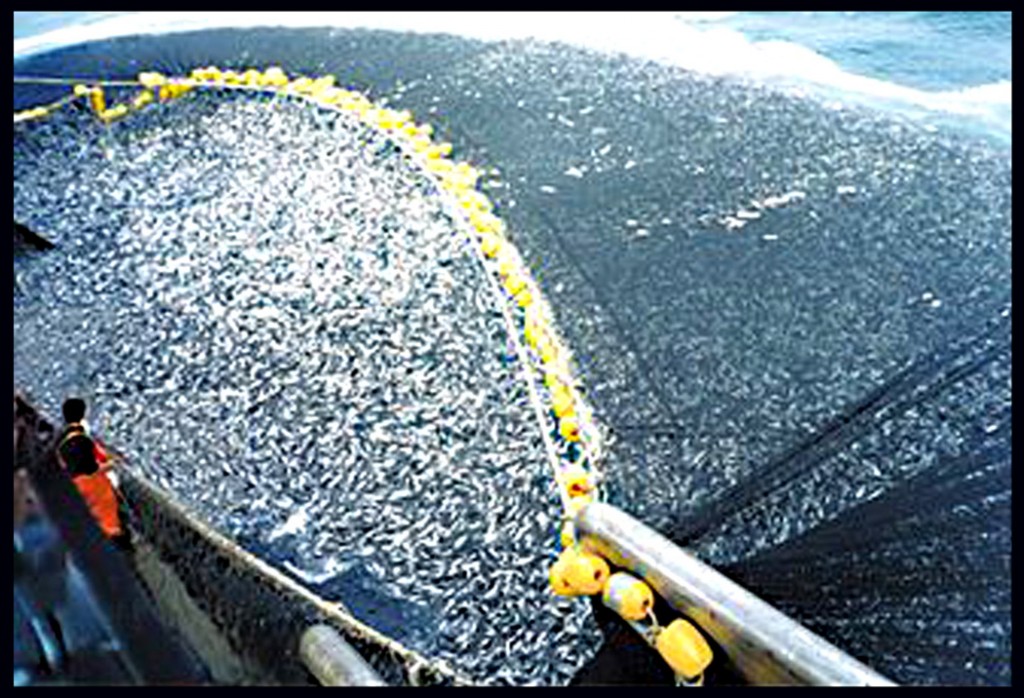 A purse seiner hauling in around 360 metric tons (400 tons) of mackerel off Peru.
A purse seiner hauling in around 360 metric tons (400 tons) of mackerel off Peru.
Over 3 million vessels are employed in sea fishing.[193] Modern fishing vessels include fishing trawlers with a small crew, stern trawlers, purse seiners, long-line factory vessels, and large factory ships which are designed to stay at sea for weeks, processing and freezing great quantities of fish. The equipment used to capture the fish may be purse seines, other seines, trawls, dredges, gillnets, and long-lines. The Food and Agriculture Organization of the United Nations is encouraging the development of local fisheries to provide food security to coastal communities and help alleviate poverty.[196]
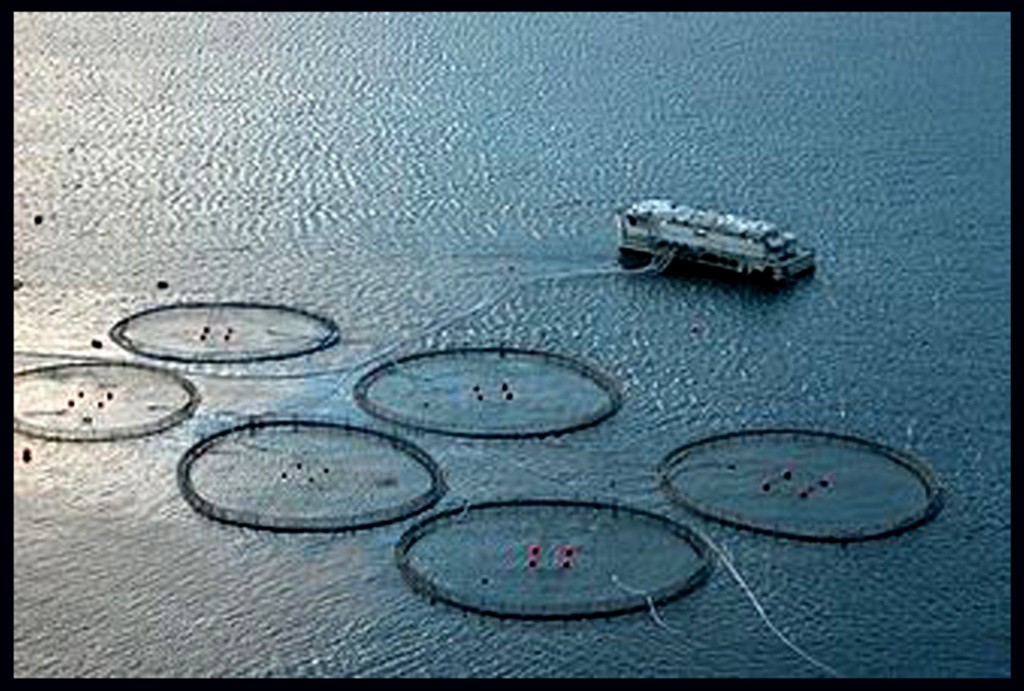 Salmon pens off Vestmanna in the Faroes.
Salmon pens off Vestmanna in the Faroes.
As well as the wild stock, about 79 million metric tons (87 million tons) of food and non-food products were produced by sea farming in 2010, an all-time high. About six hundred species of plants and animals were cultured, some for use in seeding wild populations. The animals raised included finfish, aquatic reptiles, crustaceans, molluscs, sea cucumbers, sea urchins, sea squirts, and jellyfish.[197] Integrated mariculture has the advantage that there is a readily-available supply of planktonic food and waste is removed naturally;[198] in cases where the waste would otherwise be harmful, multi-species techniques can used to, e.g., feed farmed shellfish from the waste being produced by farmed salmon. Various methods are employed. Mesh enclosures for finfish can be suspended in the open seas, cages can be used in more sheltered waters, or ponds can be refreshed with water at each high tide. Shrimps can be reared in shallow ponds connected to the open sea.[199] Ropes can be hung in water to grow algae, oysters, and mussels. Oysters can be reared on trays or in mesh tubes. Sea cucumbers can be ranched on the seabed.[200] Captive breeding programmes have raised lobster larvae for release of juveniles into the wild resulting in an increased lobster harvest in Maine.[201] At least 145 species of seaweed—red, green, and brown algae—are eaten worldwide, some long farmed in Japan and other Asian countries; there is great potential for additional algaculture.[202] Few maritime flowering plants are widely used for food but one example is marsh samphire, which is eaten both raw and cooked.[203] A major difficulty for aquaculture is the tendency towards monoculture and the associated risk of widespread disease. In the 1990s, disease wiped out China’s farmed Farrer’s scallop and white shrimp and required their replacement by other species.[204] Shrimp farming has also caused the destruction of important mangrove forests throughout southeast Asia.[205]
Law
Main articles: Admiralty law and Law of the Sea
Admiralty law is the particular body of national laws applied to maritime questions and offenses, as the uncertainty of sea voyages has caused the sea to be viewed as a unique jurisdiction since antiquity. Rhodian, Roman, Byzantine, Trani, and Amalfian laws were important influences on the French, Genovese, and Hanseatic codes which established the first English courts of admiralty. Unlike the usual English common law system, the courts of admiralty hewed closer to Continental practice, leaving it open for abuse that contributed to the American Revolution.[207] The adoption of the present constitution reintroduced admiralty law to the United States, but with a relatively larger sphere for trials by jury.
The Law of the Sea is the particular body international law applied to maritime questions and offenses. Empires such as Rome and China long claimed universal jurisdiction; during the Middle Ages, Italian maritime republics such as Venice and Genoa recognized the existence of rival states but claimed the right to close the seas to their traffic. Portuguese and Spanish pursuit of similar rights over new seas and lands during the Age of Discovery and papal support of their claims was a factor in the Wars of Religion; in 1609, a jurist hired to defend a lucrative act of piracy by the Dutch East India Company penned Mare Liberum,[208] an argument in favor of freedom of the seas that ultimately produced the compromise[209] that territory extended as far as land-based cannonshot could reach, standardized to 3 nautical miles (5,556 m or 18,228 ft), and that everything beyond was international waters.[210] President Woodrow Wilson argued this principle as part of America‘s entrance into World War I and as one of his Fourteen Points afterwards; nonetheless, President Truman‘s unilateral claim of jurisdiction over the oil reserves of America’s continental shelf in 1945[211] directly led to the end of the regime.[210] The three rounds of the United Nations‘ conferences on the Law of the Sea eventually reshaped international maritime law but the United States has not ratified the present treaty but instead adopted its policies piecemeal via presidential proclamations.
The present Convention on the Law of the Sea (UNCLOS) was drafted in 1982 and came into force in 1994.[79] It states that “the high seas are open to all states, whether coastal or land-locked” and provides a non-exhaustive list of freedoms including navigation, overflight, the laying of submarine cables, the building of artificial islands, fishing, and scientific research.[212] It extended territorial waters up to 12 nautical miles (22.2 km or 13.8 mi) from a baseline generally (but not always) equivalent to the low-water line; this area is subject to national laws but free to both innocent and transit passage. (The “internal waters” landward of the baseline are solely under national control.) A “contiguous zone” of a further 12 nmi are permitted for hot pursuit of vessels charged with violating customs, taxation, immigration, or pollution laws in the territorial waters. An “exclusive economic zone” or EEZ places all exploitation of marine life and minerals within 200 nmi (370 km or 230 mi) of the baseline under national supervision. For legal purposes, the “continental shelf” is considered to be the actual continental shelf (to a depth of 200 m or 660 ft) contiguous to the baseline or 200 nmi, whichever is greater; the marine life and minerals “attached to” (or below) the seabed within this area also fall under national supervision.[210]
Ships may cross numerous time zones on a voyage, so nautical time, introduced in the 1920s, is used in international waters. Each such zone is uniformly 15 degrees of longitude wide, the ship’s clock going forward one hour per zone when travelling eastwards.[213]
War
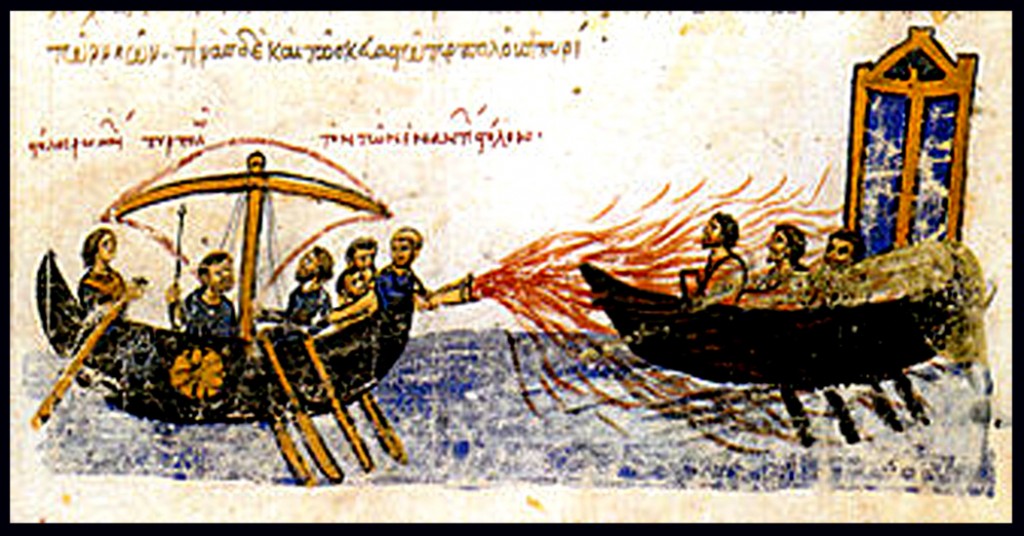 A Byzantine galley using Greek fire against rebel ships in the 9th century.
A Byzantine galley using Greek fire against rebel ships in the 9th century.
Main articles: Naval warfare, maritime geography and list of naval battles
Since the development of coordinated fleets of ships capable of landing an invasion force, naval warfare has been an important aspect in the defense (or conquest) of maritime states. The first naval battle in recorded history saw Suppiluliuma II of the Hittites burn a Cypriot fleet at sea in 1210 BC.[214] Shortly after, the fleets of the Sea Peoples disrupted the entire Eastern Mediterranean: over a period of about 50 years, raids and invasions violently destroyed nearly every coastal city between Pylos and Gaza.[215] As empires grew and their armies became too large to live off the lands through which they passed, disruption of their supply fleets also became a powerful tactic. The 480 BC Battle of Salamis largely determined the course of the Persian Wars[216] not because of its inherent damage (however considerable) but because Themistocles‘s deception and superior strategy left the Athenians capable of disrupting sea-borne supplies at will and potentially striking at the pontoon bridges across the Hellespont, cutting off the Persians’ line of retreat.[217] During the age of wooden ships, however, great fleets were burdensome to maintain and always liable to destruction by contrary weather, most famously in the case of the two kamikaze typhoons that destroyed the Mongol invasions of Japan in AD 1274 and 1281.
Piracy—both illicit in ancient Cilicia and China and state-supported among the Cretans, Vikings, Japanese, English, and Berbers[218]—has remained a problem into the present day, given the expense involved in securely protecting every merchant vessel or in policing extensive coastlines.[219]
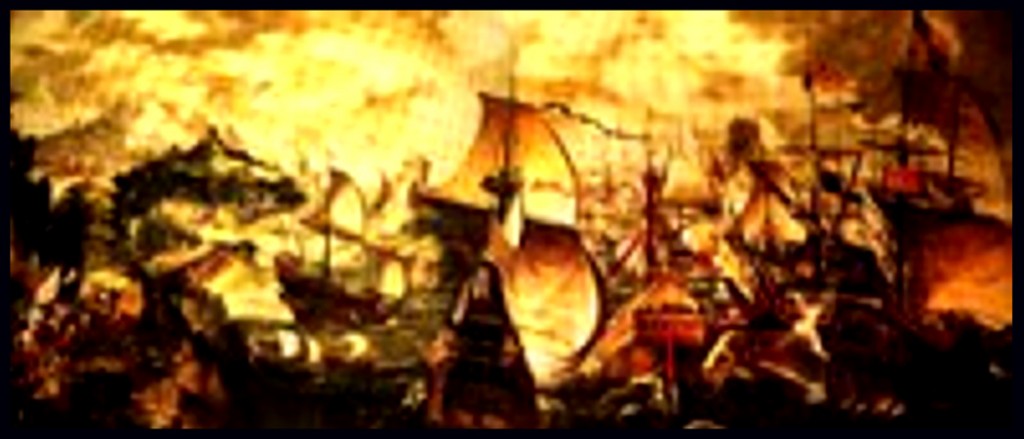 Naval warfare in the Age of Sail: contemporary painting of the 1588 Battle of Gravelines, which helped to disperse the Spanish Armada
Naval warfare in the Age of Sail: contemporary painting of the 1588 Battle of Gravelines, which helped to disperse the Spanish Armada
In the ancient world, in addition to Salamis, major naval engagements included the Battle of Actium, which permitted the establishment of Augustus‘s empire. In the modern era, important naval battles include the English victories against the Armada in 1588 and at Trafalgar in 1805,[220] which broke the threats of invasion by the superior land forces of the Spanish and French empires.
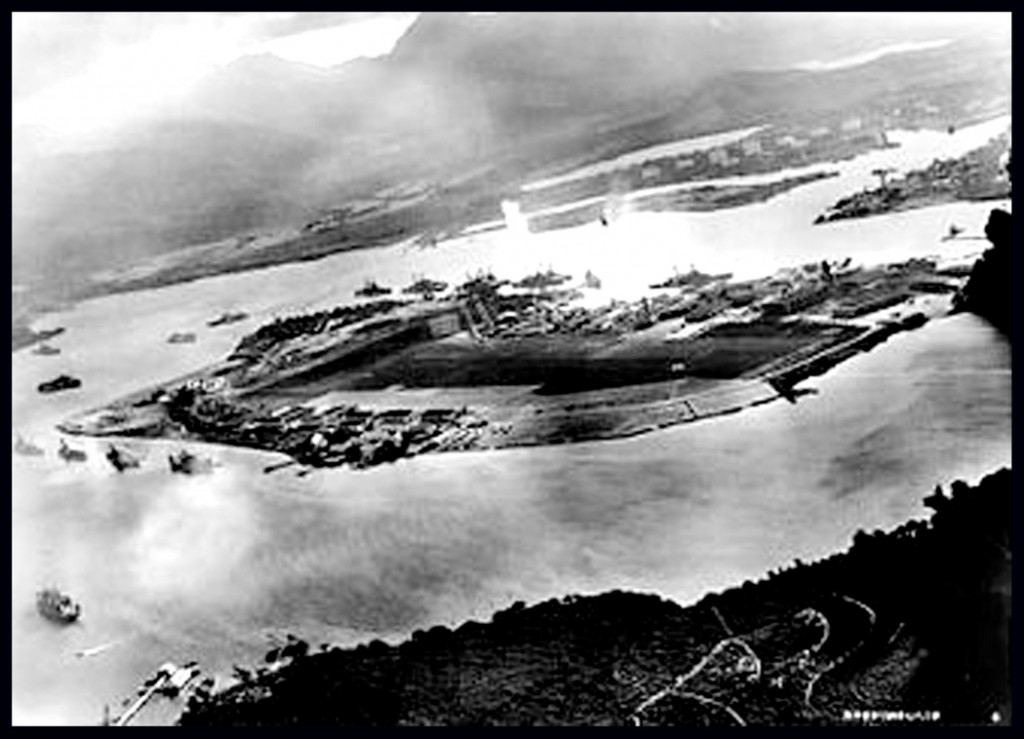 Modern naval warfare: a torpedo strikes the USS West Virginia during the Japanese attack on Pearl Harbor.
Modern naval warfare: a torpedo strikes the USS West Virginia during the Japanese attack on Pearl Harbor.
With steam, mass-produced steel plate, and exploding shells, European gunships permitted the New Imperialism of the 19th century, forcing open access to Africa, China, Korea, and Japan for their merchants on favorable terms. Although internal politics hampered Chinese modernization, American naval power produced a major reform in Japan which bore fruit during the 1905 Battle of Tsushima when the Japanese were able to decisively defeat Russia.[222] The great navies initially focused their efforts on constructing great dreadnoughts and battleships, but these fought inconclusively in the First World War.[223] By contrast, the much cheaper German U-boats showed that submarines could cripple shipping even in waters nominally controlled by the enemy.[224] Convoys, intelligence, and airborne ASW won a hard-fought victory in the Second World War‘s Battle of the Atlantic,[225] but developments in applied physics meant that by the 1960s nuclear-powered ballistic missile submarines were being maintained on constant patrol as a second-strike force[226][227] along with a second set of hunters intended to counter them. Meanwhile, the battles of the Mediterranean[228] and Pacific[229][230] theaters of the war had shown that air power was capable of overcoming the strongest warships.
Travel
Further information: Ship transport
Although the use of small private vessels for personal transport undoubtably extends back into prehistory, large ships capable of braving the open ocean were typically dedicated to trade or fishing for most of human history. Even military campaigns would often simply hire or commandeer these private fleets to serve as troop transports, as did the traders, pilgrims, and wealthy tourists of antiquity and the Middle Ages. The voyages of exploration and colonization were often provided for by the crown out of naval funds; where they were not, they were usually chartered or else purchased and then used for shipping supplies after the initial settlement. Dedicated and scheduled local passenger services came to be offered in the 16th and 17th centuries, but the 1817 Black Ball was the first trans-Atlantic passenger line. In the Age of Sail, the duration of such passages depended much on the prevailing winds and the weather. The 18th-century coastal Margate hoys began the popularization of leisure travel in Britain and Ireland[231] that later gathered steam with Thomas Cook‘s package tours in the next century.[232] During the 19th century, steam-powered ocean liners connected the railroad networks of the world. By 1900, the Atlantic crossing took about five days and the passenger lines competed to win the Blue Riband, an unofficial accolade accorded to the fastest liner in regular service. For twenty years from 1909, the prize went to the RMS Mauretania for its average speed of 26.06 knots (48.26 km/h).[233] This era waned as cheaper and faster intercontinental flights became available, most importantly the 1958 New York–Paris route.[234]
The sea still remains a venue for recreational boating and large cruise ships. It is also a route for refugees and economic migrants, some traveling in small unseaworthy craft and others smuggled into shipping vessels. Some flee persecution while many are economic migrants attempting to reach countries where they believe their prospects are brighter.[235]
Leisure
Main articles: Cruising (maritime), Sailing and Recreational boat fishing
Use of the sea for leisure developed in the nineteenth century and became a significant industry in the twentieth century.[236] Maritime leisure activities are varied and include self-organized trips cruising, yachting, powerboat racing[237] and fishing;[238] commercially organized voyages on cruise ships;[239] and trips on smaller vessels for ecotourism such as whale watching and coastal birdwatching.[240]
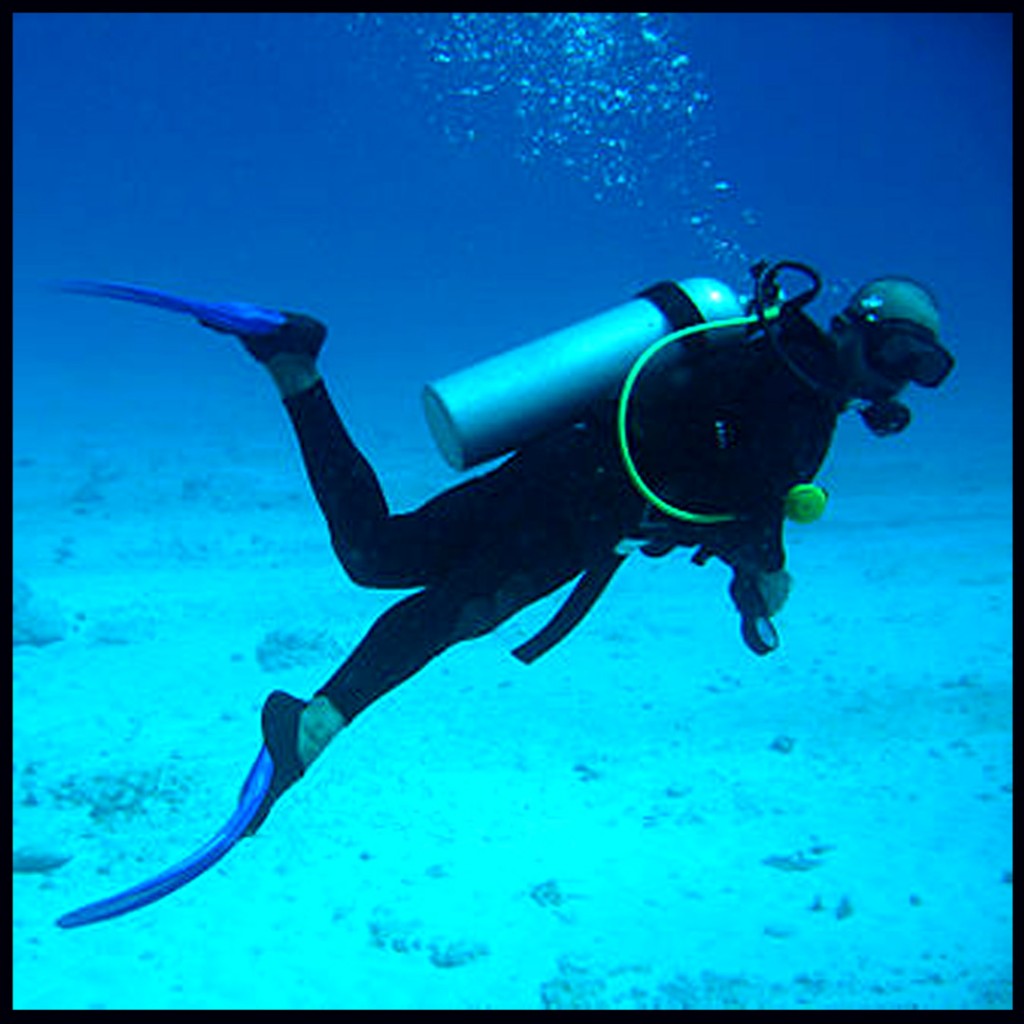 Scuba diver with face mask, fins, and underwater breathing apparatus
Scuba diver with face mask, fins, and underwater breathing apparatus
Many humans enjoy venturing into the sea: children paddle and splash in the shallows, while others swim or relax on the beach. This was not always the case, with sea bathing becoming the vogue in Europe in the 18th century after Dr. William Buchan advocated the practice for health reasons.[241] Surfing is a sport in which a wave is ridden by a surfer, with or without a surfboard. Other water sports include kite surfing, where a power kite propels a manned board across the water;[242] windsurfing, where the power is provided by a fixed, maneuverable sail;[243] and water skiing, where a powerboat is used to pull a skier.[244]
Beneath the surface, freediving is necessarily restricted to shallow descents. Pearl divers have traditionally greased their skins, put cotton in their ears and clips on their noses, and dived to 40 ft (12 m) with baskets in order to collect pearl oysters.[245] Human eyes are not adapted for use underwater, but vision can be improved by wearing a diving mask. Other useful equipment includes fins and snorkels. Scuba equipment allows underwater breathing, permitting hours of time beneath the surface.[246] The depths that can be reached by divers and the length of time they can stay underwater is limited by the increase of pressure they experience as they descend and the need to prevent decompression sickness as they return to the surface. Recreational divers are advised to restrict themselves to depths of under 100 feet (30 m) beyond which the danger of nitrogen narcosis increases. Deeper dives can be made with specialized equipment and training.[246]
Power generation
Main articles: Marine energy and Offshore wind power
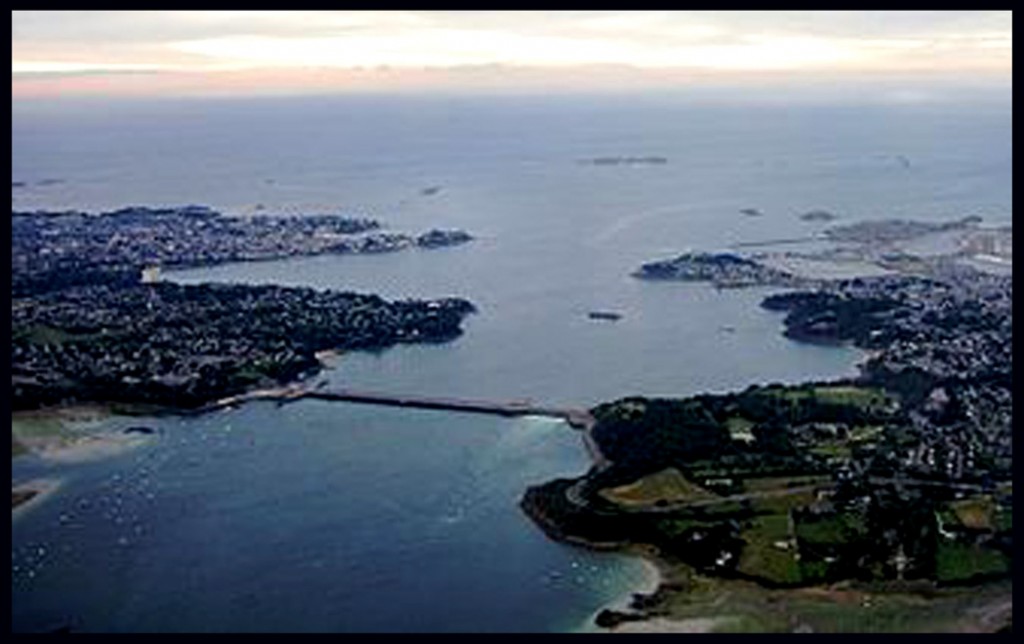 The first tidal power station in the world: the kilometer-long Rance Tidal Power Station, which produces around 540 GWh per year, around 3% of Brittany‘s total electrical consumption (2011).[247]
The first tidal power station in the world: the kilometer-long Rance Tidal Power Station, which produces around 540 GWh per year, around 3% of Brittany‘s total electrical consumption (2011).[247]
The sea offers a very large supply of energy carried by ocean waves, tides, salinity differences, and ocean temperature differences which can be harnessed to generate electricity.[248] Forms of ‘green‘ marine energy include tidal power, marine current power, osmotic power, ocean thermal energy and wave power.[248][249]
Tidal power uses generators to produce electricity from tidal flows, sometimes by using a dam to store and then release seawater. The Rance barrage, 1 kilometer (0.62 mi) long, near St Malo in Brittany opened in 1967; it generates about 0.5 GW, but it has been followed by few similar schemes.[6](pp111–112)
The large and highly variable energy of waves gives them enormous destructive capability, making affordable and reliable wave machines problematic to develop. A small 2 MW commercial wave power plant, “Osprey”, was built in Northern Scotland in 1995 about 300 meters (1000 ft) offshore. It was soon damaged by waves, then destroyed by a storm.[6](p112) Marine current power could provide populated areas close to the sea with a significant part of their energy needs.[250] In principle, it could be harnessed by open-flow turbines; sea bed systems are available, but limited to a depth of about 40 m (130 ft).[251]
Offshore wind power is captured by wind turbines placed out at sea; it has the advantage that wind speeds are higher than on land, though wind farms are more costly to construct offshore.[252] The first offshore wind farm was installed in Denmark in 1991,[253] and the installed capacity of European offshore wind farms reached 3 GW in 2010.[254]
Electricity power stations are often located on the coast or beside an estuary so that the sea can be used as a heat sink. A colder heat sink enables more efficient power generation, which is important for expensive nuclear power plants in particular.[255]
Extractive industries
Main articles: Offshore drilling and Deep sea mining
A reverse osmosis desalination plant
There are large deposits of petroleum (as oil and natural gas) in rocks beneath the seabed. Offshore platforms and drilling rigs extract the oil or gas and store it for transport to land. Offshore oil and gas production can be difficult due to the remote, harsh environment.[256] Drilling for oil in the sea has environmental impacts. Animals may be disorientated by seismic waves used to locate deposits, probably causing the beaching of whales.[257] Toxic substances such as mercury, lead, and arsenic may be released. The infrastructure may cause damage and oil may be spilt.[258]
A black smoker releasing dissolved sulfides and other minerals amid its superheated jets of water.
The sea holds enormous quantities of valuable dissolved minerals.[259] The most important, Salt for table and industrial use has been harvested by solar evaporation from shallow ponds since prehistoric times. Bromine, accumulated after being leached from the land, is economically recovered from the Dead Sea, where it occurs at 55,000 parts per million (ppm).[260] Other minerals on or within the seabed can be exploited by dredging. This has advantages over land-based mining in that equipment can be built at specialized shipyards and infrastructure costs are lower. Disadvantages include problems caused by waves and tides, the tendency for excavations to silt up, and the washing away of spoil heaps. There is a risk of coastal erosion and environmental damage.[261] Sulphide deposits are potential sources of silver, gold, copper, lead, zinc, and trace metals which were only discovered in the 1960s. They form when geothermally superheated water is emitted from deep sea hydrothermal vents known as “black smokers”: in contact with the cold waters of the deep ocean, the minerals precipitate and settle around the vent. The ores are of high quality but currently very costly to extract.[262] Small scale mining of the deep sea floor is being developed off the coast of Papua New Guinea using robotic techniques, but the obstacles are formidable.[263]
Desalination is the technique of removing salts from seawater to leave fresh water suitable for drinking or irrigation. The two main processing methods, vacuum distillation and reverse osmosis, use large quantities of energy. Desalination is normally only undertaken where fresh water from other sources is in short supply or energy is plentiful, as in the excess heat generated by power stations. The brine produced as a by-product contains some toxic materials and is returned to the sea.[264]
Large quantities of methane clathrate exist on the seabed and in ocean sediment at a temperature of around 2 °C (36 °F) and these are of interest as a potential energy source. Some estimates put the amount available at between one and 5 million cubic kilometers (0.24 to 1.2 million cubic miles).[265] Also on the seabed are manganese nodules formed of layers of iron, manganese, and other hydroxides around a core. In the Pacific these may cover up to 30 percent of the deep ocean floor. The minerals precipitate from seawater and grow very slowly. Their commercial extraction for nickel was investigated in the 1970s but abandoned in favour of more convenient sources.[266] In suitable locations, diamonds are gathered from the seafloor using suction hoses to bring gravel ashore. In deeper waters, mobile seafloor crawlers are used and the deposits are pumped to a vessel above. In Namibia, more diamonds are now collected from marine sources than by conventional methods on land.[267]
Pollution
Main article: Marine pollution
Many substances enter the sea as a result of human activities. Combustion products are transported in the air and deposited through precipitation. Agricultural, industrial, and sewage outflows contribute heavy metals, pesticides, PCBs, disinfectants, cleaning products, and other synthetic chemicals. These become concentrated in the surface film and in marine sediment, especially estuarine mud. The result of all this contamination is largely unknown because of the large number of substances involved and the lack of information on their biological effects.[268] The heavy metals of greatest concern are copper, lead, mercury, cadmium, and zinc which may be accumulated by marine invertebrates. They are then passed up the food chain.[269]
Run-off of fertilizers from agricultural land is a major source of pollution in some areas and the discharge of raw sewage has a similar effect. The extra nutrients provided by these sources can cause excessive plant growth. Nitrogen is often the limiting factor in marine systems and the addition of nitrogen sparks algal blooms and red tides, which then may lower the oxygen level of the water to the point where it kills marine animals. Such events have created dead zones in the Baltic Sea and the Gulf of Mexico.[270] Some algal blooms are caused by cyanobacteria that make shellfish that filter feed on them toxic, harming animals like sea otters.[271] Nuclear facilities too can pollute. The Irish Sea was contaminated by radioactive caesium-137 from the former Sellafield nuclear fuel processing plant[272] and nuclear accidents sometimes cause radioactive material to seep into the sea, as at the Fukushima in 2011.[273]
The dumping of waste (including oil, noxious liquids, sewage, and garbage) at sea is governed by international law. The London Convention (1972) is a United Nations agreement to control ocean dumping which had been ratified by 89 countries by 8 June 2012.[274] MARPOL 73/78 is a convention to minimize pollution of the seas by ships. By May 2013, 152 maritime nations had ratified MARPOL.[275]
Much floating plastic trash does not biodegrade, instead disintegrating over time and eventually breaking down to the molecular level. Rigid plastics may float for years.[276] In the center of the Pacific gyre, there is a permanent floating accumulation of mostly plastic waste[277] and there is a similar garbage patch in the Atlantic.[278] Foraging sea birds such as the albatross and petrel may mistake debris for food and accumulate indigestible plastic in their digestive systems. Turtles and whales have been found with plastic bags and fishing line in their stomachs. Microplastics may sink, threatening filter feeders on the seabed.[279]
Most oil pollution in the sea comes from cities and industry.[270] Oil is dangerous for marine animals. It can clog the feathers of sea birds, reducing their insulating effect and the birds’ buoyancy, or be ingested when they preen themselves in an attempt to remove the contaminant. Marine mammals are less seriously affected but may be chilled through the removal of their insulation, blinded, dehydrated, or poisoned. Benthic invertebrates are swamped when the oil sinks, fish are poisoned, and the food chain is disrupted. In the short term, oil spills result in wildlife populations being decreased and unbalanced, leisure activities being affected, and the livelihoods of people dependent on the sea being devastated.[280] The marine environment has self-cleansing properties and naturally-occurring bacteria will act over time to remove oil from the sea. In the Gulf of Mexico, where oil-eating bacteria are already present, they take only a few days to consume spilt oil.[281]
Indigenous sea peoples
Several nomadic indigenous groups in Maritime Southeast Asia live in boats and derive nearly all they need from the sea. The Moken people live on the coasts of Thailand and Burma and islands in the Andaman Sea.[282] The Bajau people are originally from the Sulu Archipelago, Mindanao, and northern Borneo.[283] Some Sea Gypsies are accomplished free-divers, able to descend to depths of 30 m (98 ft), though many are adopting a more settled, land-based way of life.[284][285]
The indigenous peoples of the Arctic such as the Chukchi, Inuit, Inuvialuit, and Yupik hunt marine mammals including seals and whales[286] and the Torres Strait Islanders claim ownership of the Great Barrier Reef. They live a traditional life on the islands involving hunting, fishing, gardening, and trading with neighboring peoples in Papua New Guinea and Australia.[287]
For more information please visit Wikipedia. The link is:
https://en.wikipedia.org/wiki/World_Ocean
The Great Barrier Reef A Fragile Empire
https://www.bbc.com/travel/story/20120815-the-great-barrier-reef-a-fragile-empire
From tiny coral polyps grew Australia’s Great Barrier Reef, the largest living structure on Earth. But a changing environment could put the reef’s future in jeopardy.
The Great Barrier Reef, the largest living structure on Earth, is the product of billions of tiny organisms called polyps which secrete calcium carbonate during photosynthesis to form coral. Soft corals cling to hard corals, algae and sponges paint the rocks, and every crevice is a creature’s home. But this fragile coral colony is beginning to crumble, battered by the effects of climate change, pollution and manmade disasters. (David Doubilet/National Geographic Stock)
Corals grow best in shallow, clear and turbulent water with lots of light to support photosynthesis. The Great Barrier Reef formed 25 million years ago when coral larvae in the Indo-Pacific caught south-flowing currents and grabbed footholds off Australia’s eastern edge where conditions are ripe for coral flowering. Slowly, rocky colonies grew and spread along the seafloor. Today, the reef stretches for more than 2,600km and covers an area of 25,900sqkm; wide ribbons of the Great Barrier Reef divide the continental shelf from the deep waters of the Coral Sea. (David Doubilet/National Geographic Stock)
Since the reef first found its footing, ice ages have come and gone, tectonic plates have shifted, and ocean and atmospheric conditions have fluctuated wildly. The reef has undergone many iterations, being defaced and repopulated at nature’s whim. Its resilience is undeniable; after every flux, the coral has rebounded and life has returned. Now, however, all the factors that allow the reef to grow are changing at a rate the Earth has never before experienced. (David Doubilet/National Geographic Stock)
Of course, for the two million tourists who visit the reef each year, the promise of an underwater paradise teeming with life is still fulfilled. The reef is host to 5,000 types of molluscs, 1,800 species of fish (like the humphead wrasse, pictured – a fish that can reach 2m in length) and 125 kinds of sharks. Divers often spot moray eels, white tip reef sharks and stingrays; at this underwater theatre, nature delivers a superb performance. (David Doubilet/National Geographic Stock)
The blemishes caused by climate change and human error are visible to those who know where to look. The reef bears a two-mile-long scar from a collision with a Chinese coal carrier in April 2010. Other ship groundings and occasional oil spills have marred the habitat. Sediment plumes from flooding on the mainland nutrients from agriculture and development also damage the ecosystem. To sustain the reef’s diversity of sea life, as pictured at Pixie Pinnacle (one of the Great Barrier Reef’s signature dive sites), coral polyps must be allowed to flourish. (David Doubilet/National Geographic Stock)
Beyond the reef is the open ocean of the Coral Sea, home to a variety of different and much larger life forms than the nooks and crannies of the shallow reef. Drawn to the smell of a dead sperm whale, a 3m tiger shark arrives at the edge of the reef to feast on the floating flesh. Bits of food left uneaten will fall to feed the reef’s smaller residents. (David Doubilet/National Geographic Stock)
Even with all these threats against it, the Great Barrier Reef is an empire determined to survive. The challenge scientists face is to keep the reef healthy despite rapid change. Coral survival is possible long term if the onslaughts are halted. It has, after all, toughed it out through catastrophic change like this before — but it needs to happen soon. (David Doubilet/National Geographic Stock)
For more information please visit the following link:
https://www.bbc.com/travel/story/20120815-the-great-barrier-reef-a-fragile-empire
Whale migration
The big question still is: Why do these mammals embark on these seasonal movements?
Climate changes, water temperature, depth, salinity, topography of the sea floor and the biggest, abundance of food, all plays a major roll in these events.
 Although most baleen whales are found in all oceans, they still take on these extensive migrations. These migrations are time-coupled to the breeding/mating season.
Although most baleen whales are found in all oceans, they still take on these extensive migrations. These migrations are time-coupled to the breeding/mating season.
Whales travel to cold waters for feeding; they go to warmer waters to give birth. One of the most dramatic whales that visits the Gulf of Maine is the humpback whale, whose Latin name Megaptera novaeangliae means “big-winged New Englander.” It is known for its spectacular leaps and long, white side flippers. About 100 humpback whales arrive on Stellwagen Bank, a newly designated marine sanctuary off Massachusetts, in the spring to feed on slender, five-inch-long fish called sand launce.
The Dominican Republic has made these whales’ birthing grounds on Silver Banks, just north of that Caribbean country, a marine sanctuary. After giving birth during the winter or early spring, mothers bring their calves to the rich feeding grounds of Stellwagen Bank or other parts of the Gulf of Maine. Like all mammals, the mothers nurse their young. A 10-15 foot baby humpback may nurse as long as a year, adding up to 15 feet in length each month. An adult humpback may grow to be up to 50 feet long.
Southern right whale migration.
Winter/Spring: During the winter and spring, they are found in their coastal mating and calving grounds. These lie mainly along the southern coasts of Africa (Hermanus, South Africa is a particularly good place to see them), South America (around Chile & Argentina – Peninsula Valdes is a well-known habitat) and in the Great Australian Bight, as well as along the western coast of New Zealand
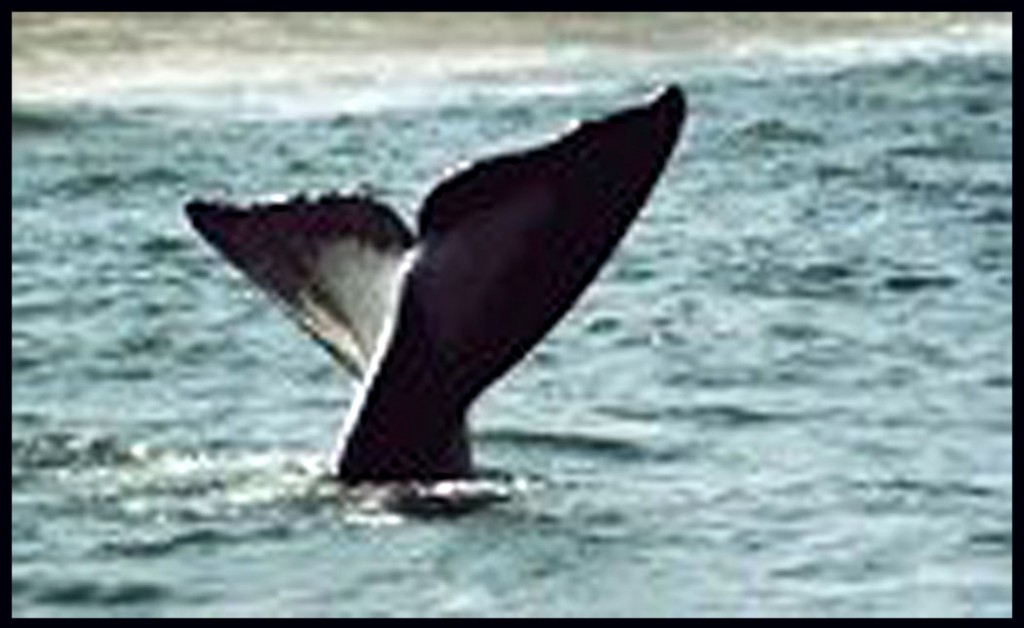 Summer: Southern right whales migrate to colder food-rich waters near Antarctica for the summer, but to where exactly is not known. Most appear to stay in the mid-Southern Ocean but some do feed at the edge of the pack-ice.
Summer: Southern right whales migrate to colder food-rich waters near Antarctica for the summer, but to where exactly is not known. Most appear to stay in the mid-Southern Ocean but some do feed at the edge of the pack-ice.
Blue whales:
Winter: warm, low latitude tropical waters (breed and give birth)
Summer: cooler, high latitude polar waters (feeding)
 Most blues are migratory and travel thousands of kilometres annually between their winter breeding grounds in warmer, low latitude waters around the tropics, where they mate and give birth, and their summer feeding grounds in the cooler, high latitude waters of either the Arctic and Antarctic, where they feed for 3-4 months on the rich supply of krill and other food which occur in huge numbers in polar waters
Most blues are migratory and travel thousands of kilometres annually between their winter breeding grounds in warmer, low latitude waters around the tropics, where they mate and give birth, and their summer feeding grounds in the cooler, high latitude waters of either the Arctic and Antarctic, where they feed for 3-4 months on the rich supply of krill and other food which occur in huge numbers in polar waters
They then migrate back to the tropics segregated by sex and age, the older and pregnant whales migrating first, with the sexually immature whales bringing up the rear. Generally, the larger, older whales migrate the furthest north.
During this migration, they eat virtually nothing for at least 4 months and live on body reserves. Females give birth in warm tropical waters because the young only have a thin layer of blubber to keep them warm. Females give birth to a single calf about 7m long and weighing 2.5 tonnes. The calves are suckled for 7 months and follow their mothers on the spring migration towards the polar seas. Once weaned, the calves feed on krill and follow the normal migration cycle.
Grey Whales
The basic migration pattern follows that of most baleen whales, ie between: winter breeding grounds in low latitude, warm waters and summer feeding areas in higher latitudes, cool waters

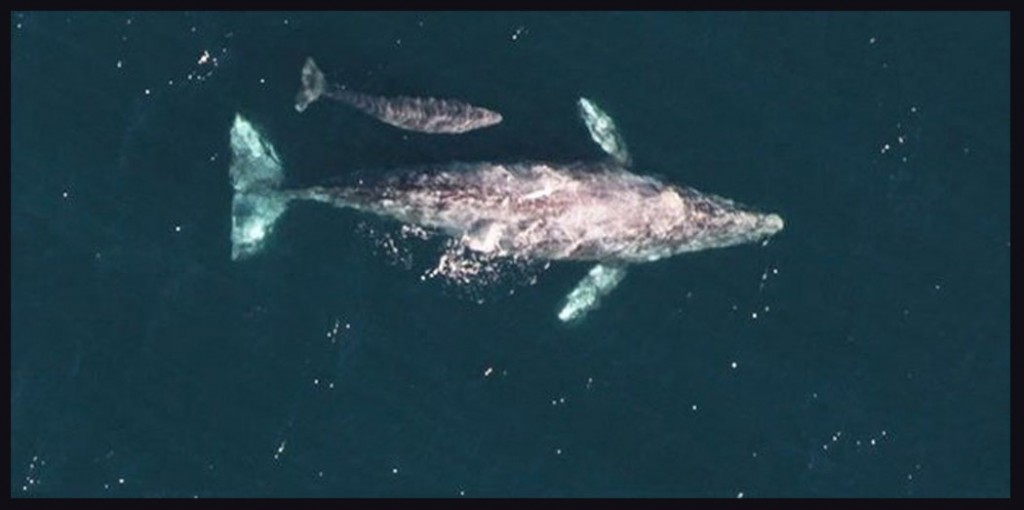 i) Western North Pacific This tiny, remnant population migrates north from winter calving grounds off the Korean Peninsula and Japan, to summer feeding grounds in the northern Okhotsk Sea.
i) Western North Pacific This tiny, remnant population migrates north from winter calving grounds off the Korean Peninsula and Japan, to summer feeding grounds in the northern Okhotsk Sea.
ii) Eastern North Pacific gray whales make a mammoth 20,000 km (12,400 mile) round trip between their southern breeding grounds off Baja California, Mexico and their northern feeding grounds off Alaska and the Beaufort Sea.
April – November: Arctic feeding grounds
[October – February: migrates south]
December – April: Mexican breeding grounds
[February – July: migrates north]
In the early winter, they move south to breed in the warm, shallow lagoons along the Mexican coast. The most popular breeding lagoons are San Ignacio lagoon, Scammon’s lagoon, and Magdalena Bay, on the Pacific coast of Baja California, Mexico. Around February, the grays migrate north to feed in Arctic waters (western Beaufort Sea and Bering Sea), northwest of Alaska. A few – mainly younger – whales make a shorter journey north from Mexico, stopping off along the coastline stretching between northern California, Oregon, Washington State, USA, and British Columbia, Canada. Some feeding behaviour has been observed in all parts of the range, and around Vancouver Island, British Columbia, Canada, grays are present year-round.
Humpbacks
Winter: warm, low latitude tropical waters (breed and give birth)
Spring/Summer/Autumn: cooler, high latitude polar waters (feed)
Most humpback whales make mammoth journeys every year between their feeding and breeding sites. Because seasons are reversed either side of the equator, Northern and Southern Hemisphere populations of humpbacks probably never meet; those in the north travel towards their breeding grounds in tropical waters as those in the south are travelling towards the pole to feed, and vice versa.
Humpbacks are capable of travelling at 5 mph but, during such a long journey, they average only 1 mph, resting and socialising along the way. Not all members of a particular population will travel together however. For example, the humpbacks that pass the eastern shores of Australia, on their way to summer feeding grounds in Antarctica each year, stop off in the warm waters of Hervey Bay. The first to arrive there are groups of older juveniles, followed by mature males and then by mothers and calves.
Northern right whales
They are not known to travel the huge distances that species such as humpbacks and grays do. Nonetheless, some make annual migrations between winter breeding and calving grounds in warmer southern waters, and summer feeding grounds in cooler waters.

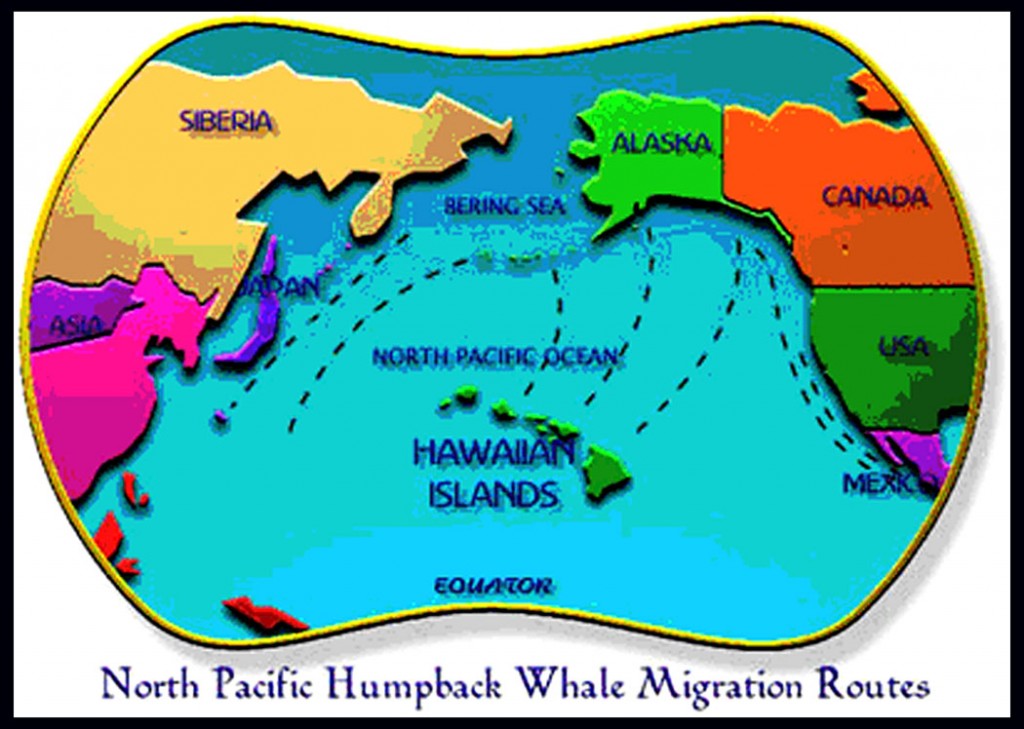 Winter: Most females give birth in the coastal waters of Southeast USA, off the states of Florida and Georgia. However, males and non-calving females are rarely seen in this area and their whereabouts during the winter is not known.
Winter: Most females give birth in the coastal waters of Southeast USA, off the states of Florida and Georgia. However, males and non-calving females are rarely seen in this area and their whereabouts during the winter is not known.
Spring: In the spring, aggregations of northern rights can be seen in the Great South Channel, east of Cape Cod, and in Massachusetts Bay as they travel north to their summer grounds.
Summer/Autumn: During the summer and autumn, both sexes are found in the Bay of Fundy (between Maine in the USA and Nova Scotia in Canada), and in an area on the continental shelf, 50 km south of Nova Scotia. There is also thought to be at least one other summer/autumn habitat somewhere in the North Atlantic.
For more information please visit the following link:
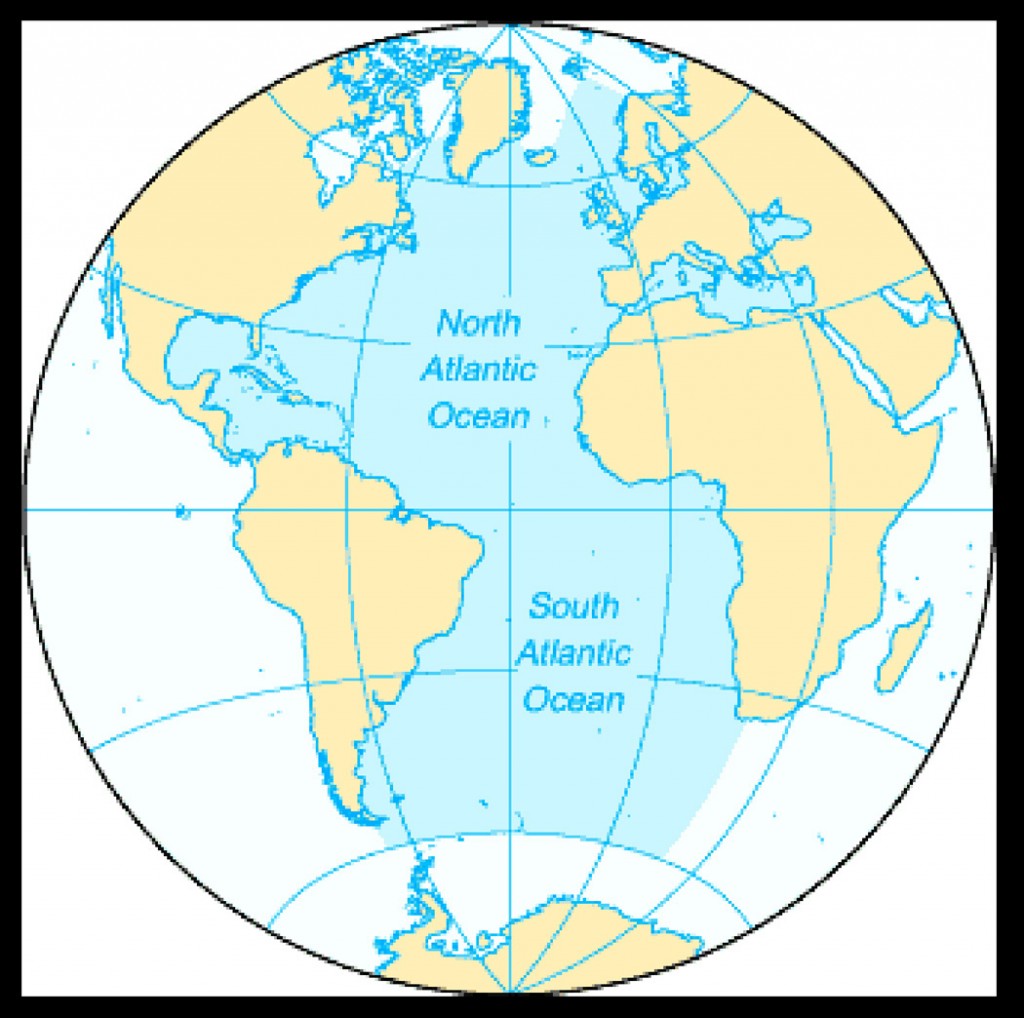

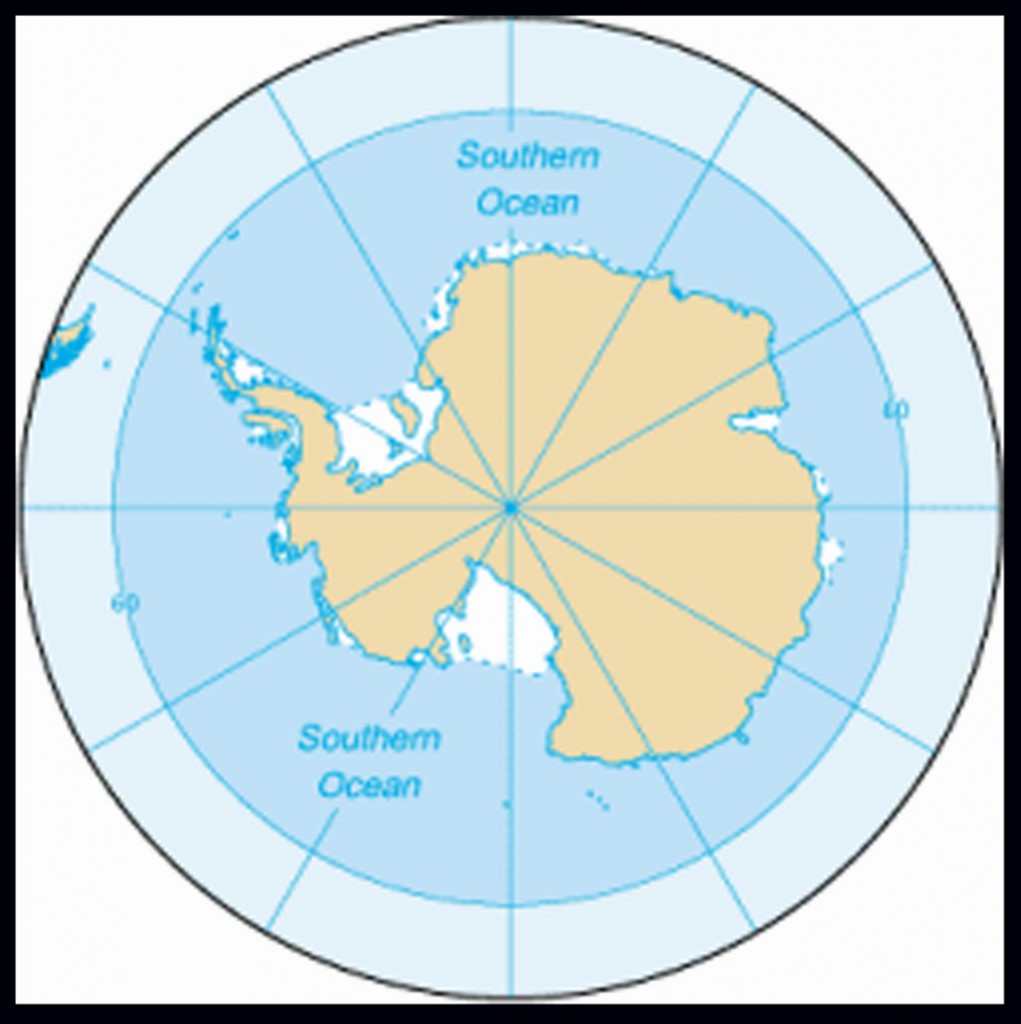

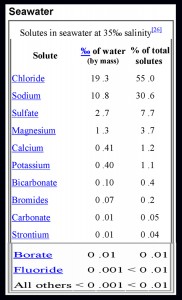
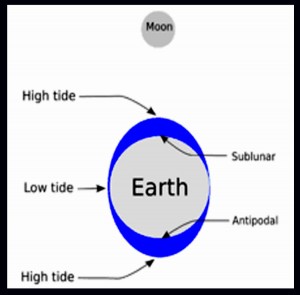
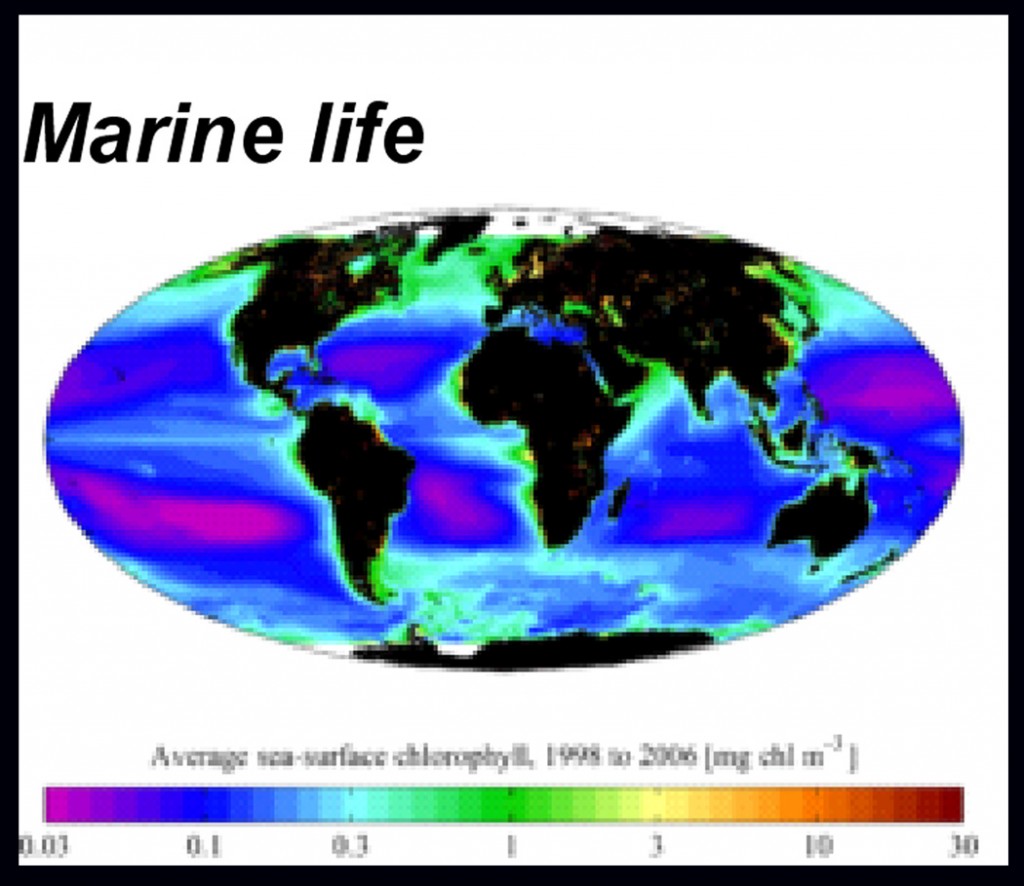
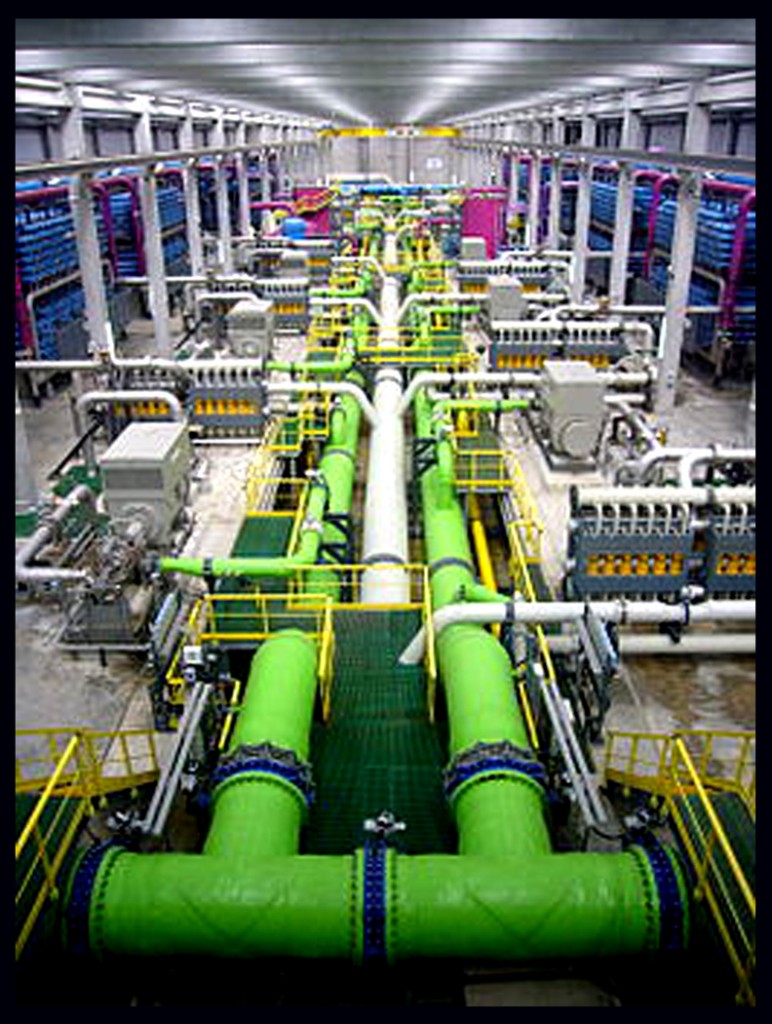
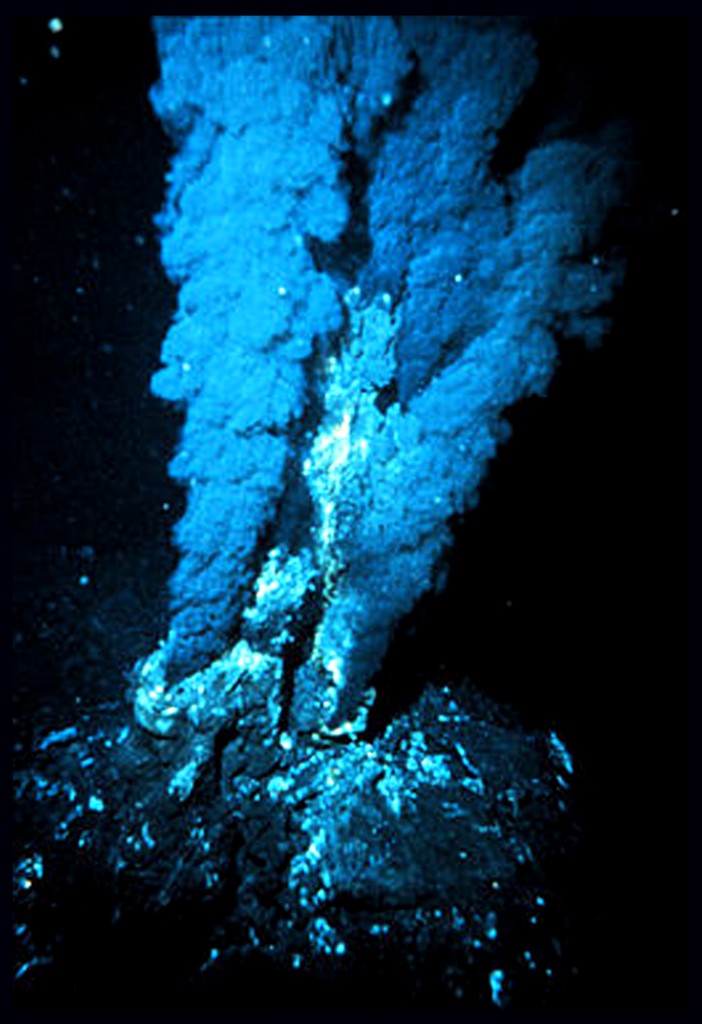
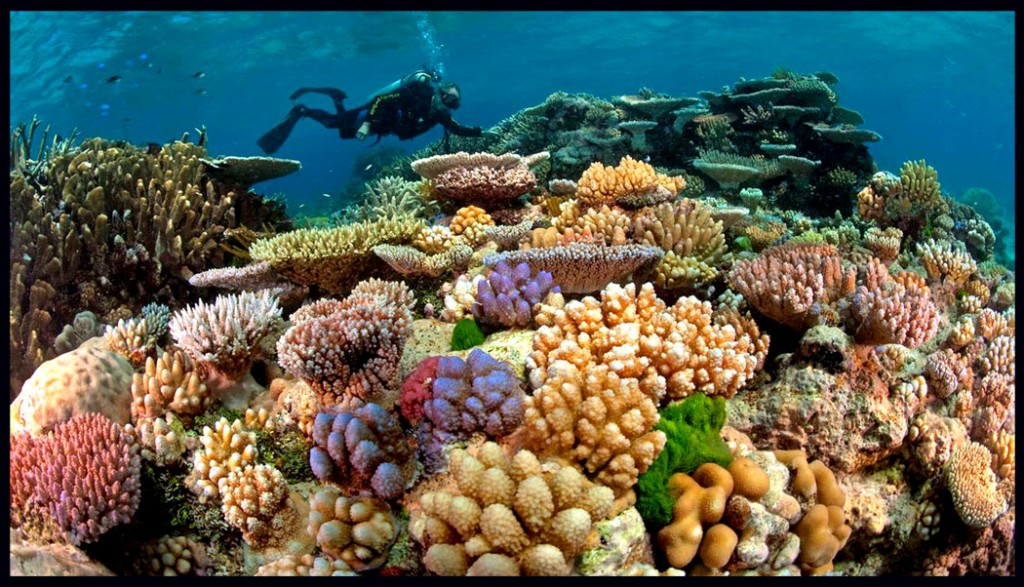

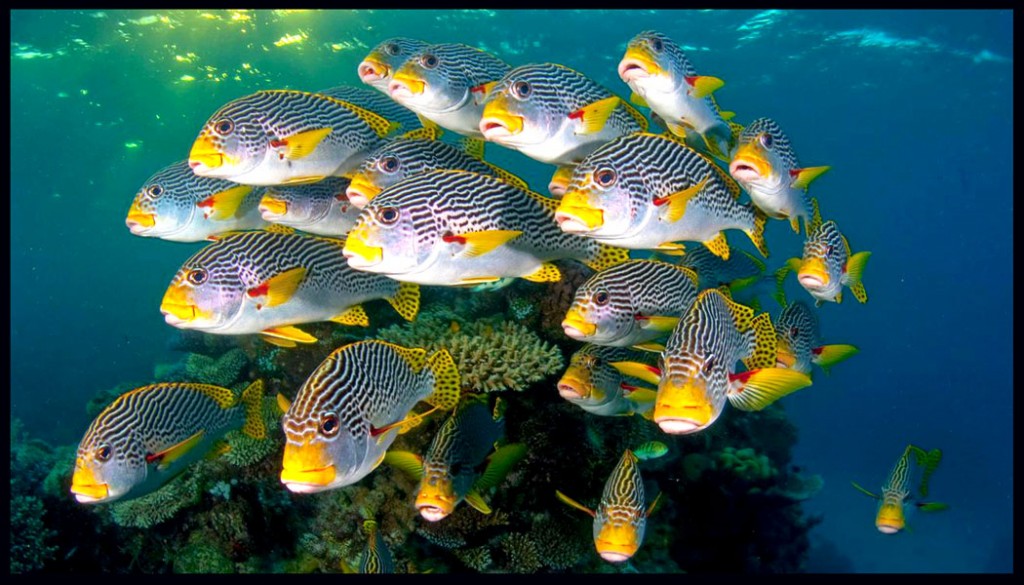
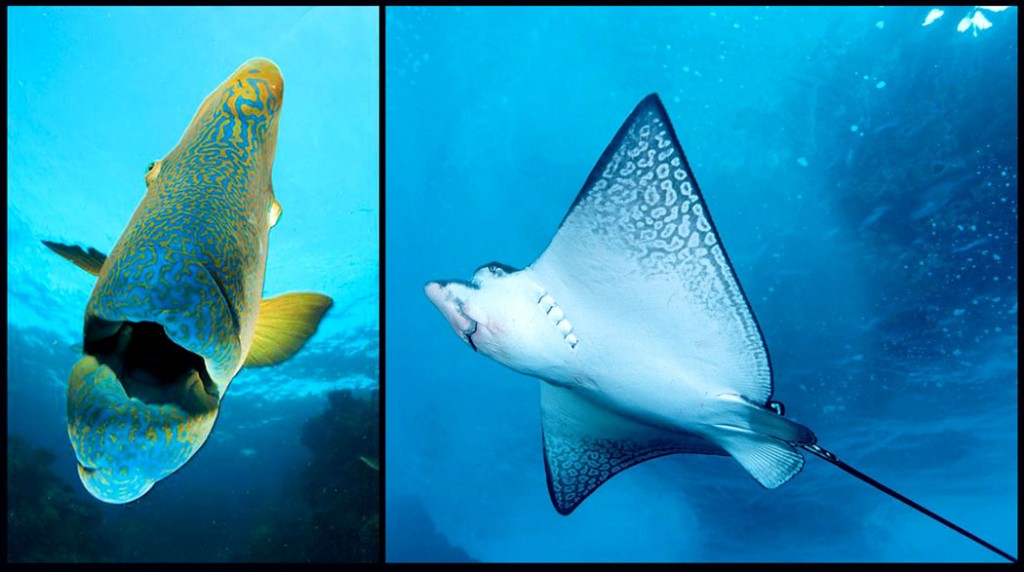
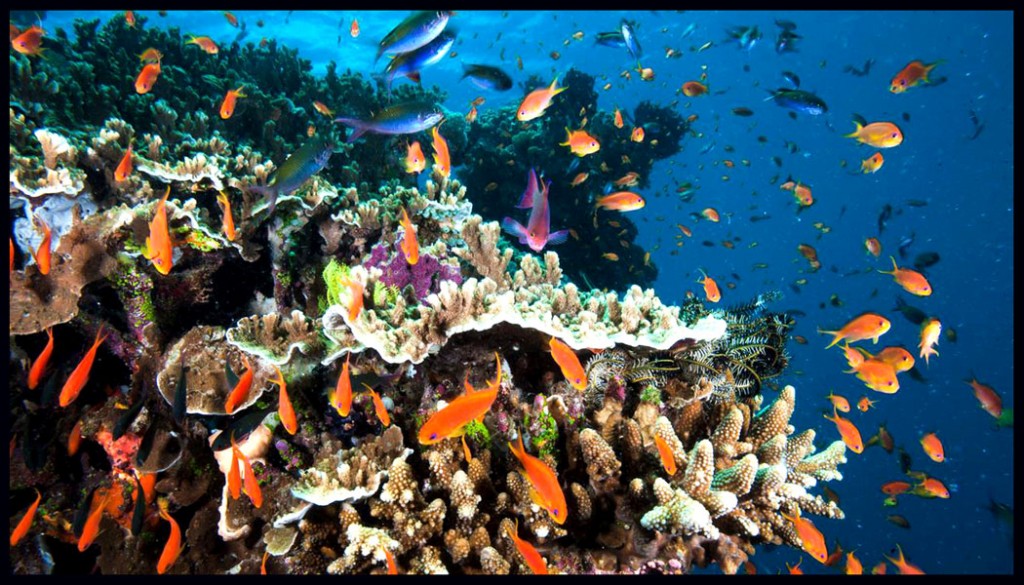
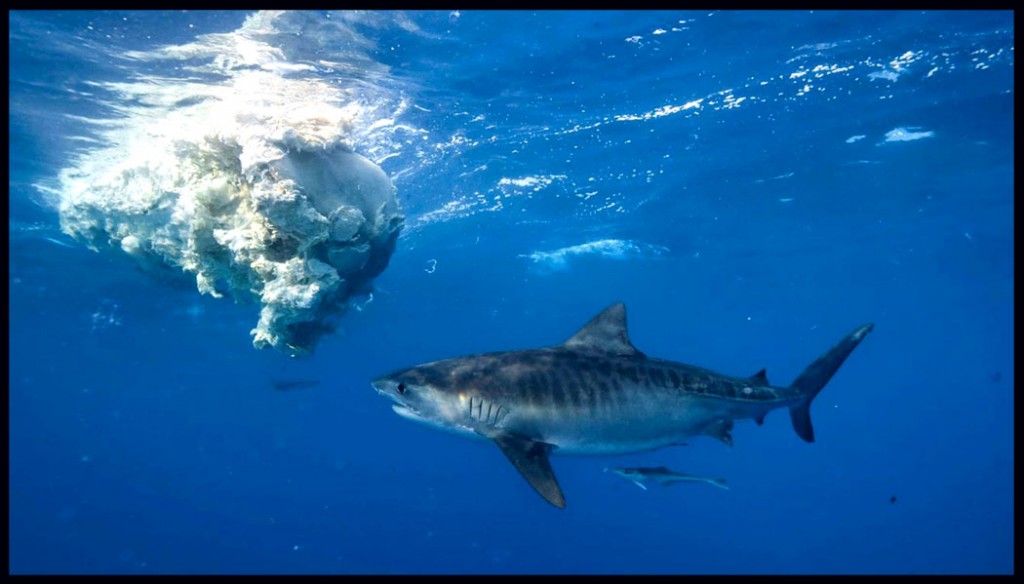
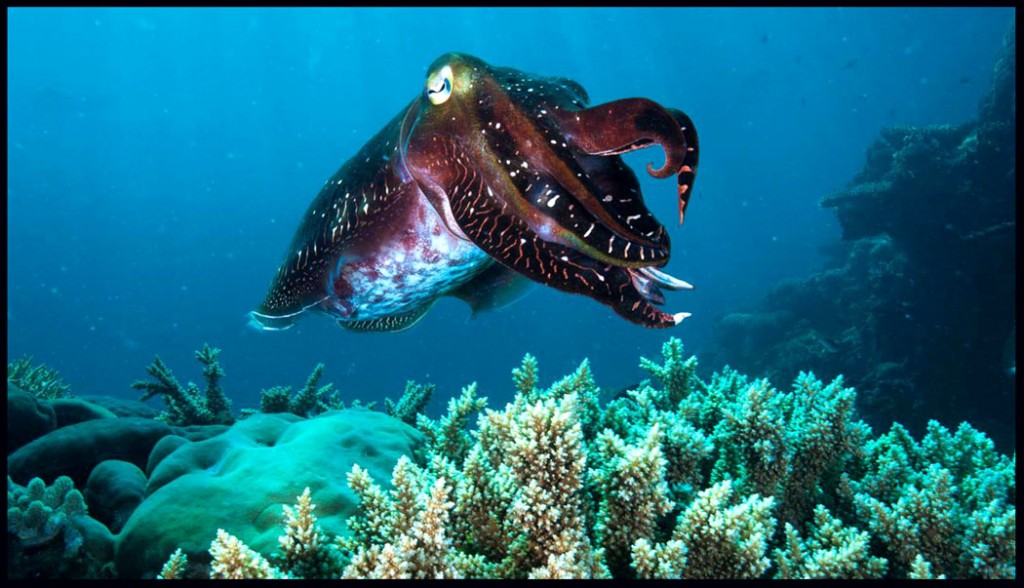

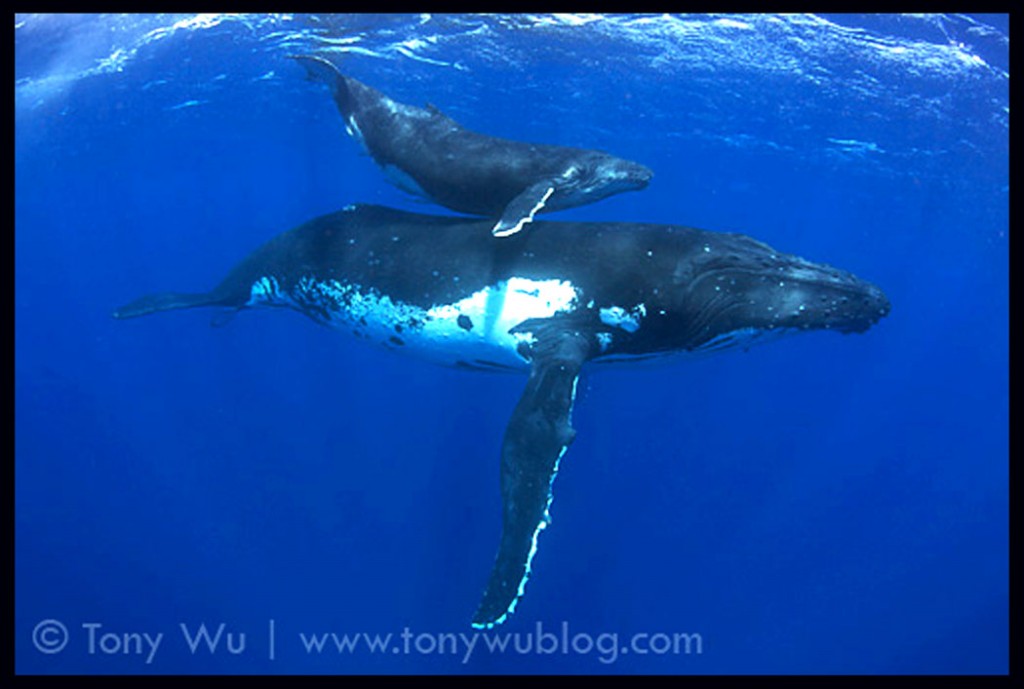
Leave a Reply